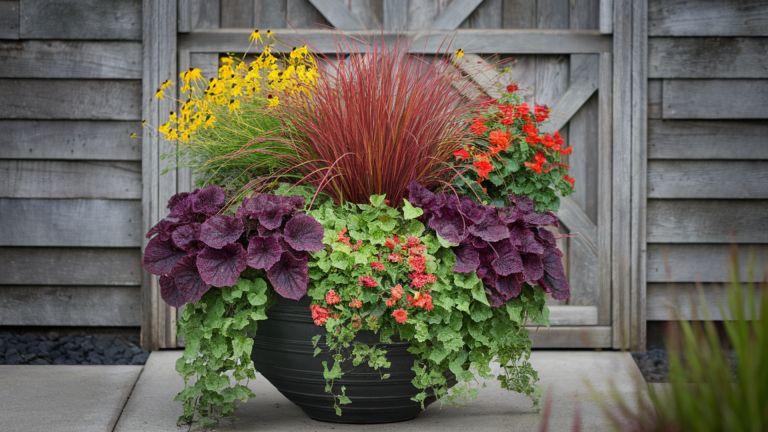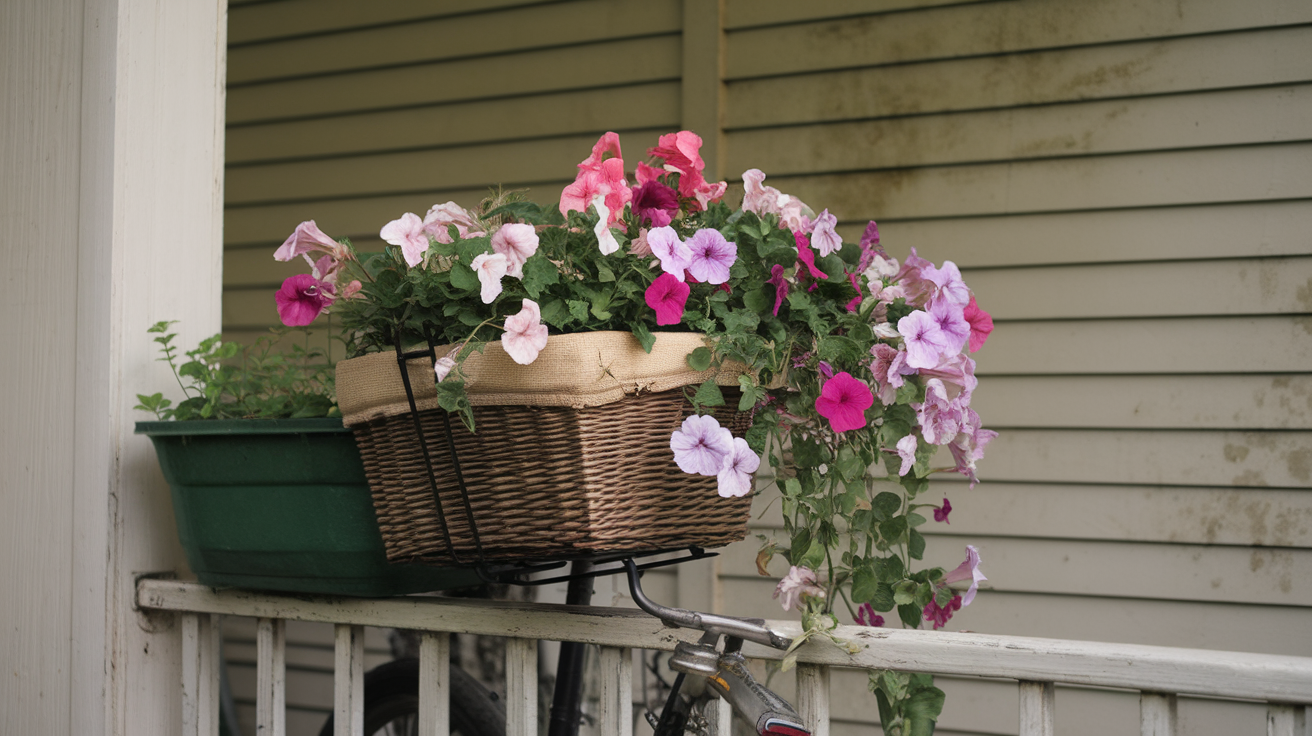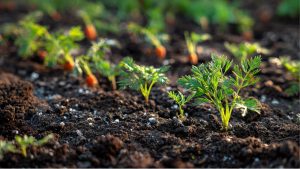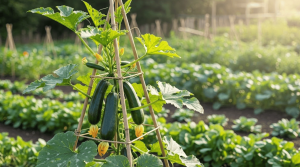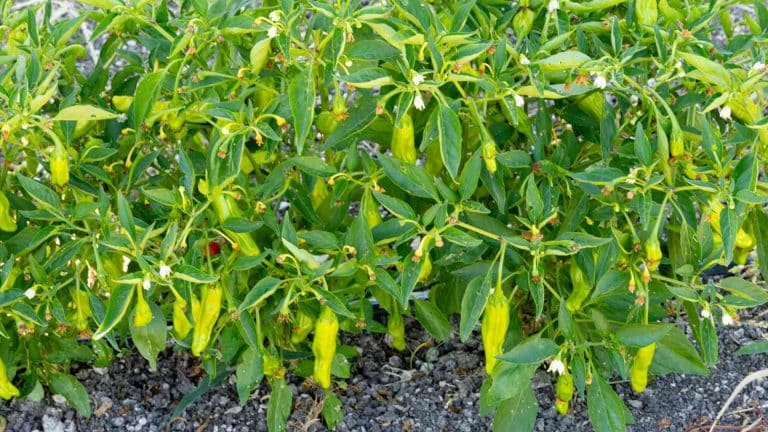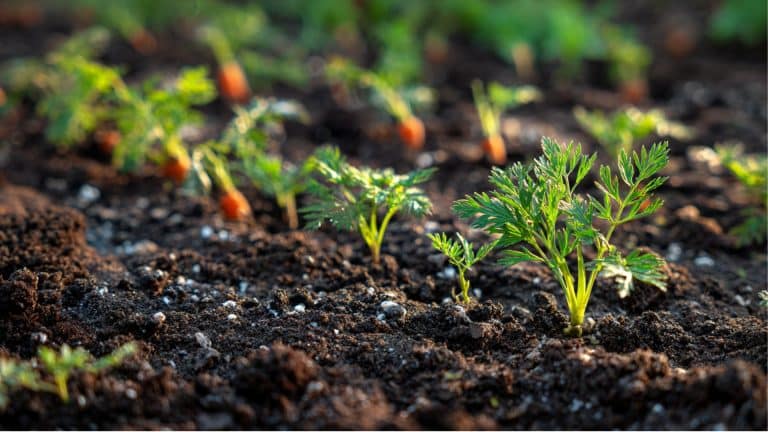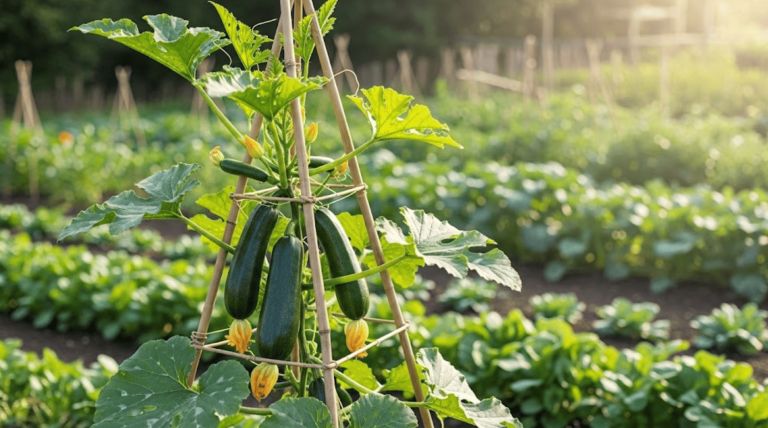If you’re looking for easy ways to brighten up your porch, patio, or balcony, flower pots are a great place to start.
They’re simple to use, don’t take up much space, and you can move them around as needed. In this post, you’ll find some flower pot ideas that work well for small outdoor areas.
This is what you’ll get:
- Creative ways to style pots
- Ideas for all kinds of spaces
- Tips on plant choices for shade or sun
I started with just a few leftover containers on my apartment balcony, and it made the whole space feel more welcoming.
It doesn’t take much, just the right mix of plants and containers. So if you want a porch or patio that feels fresh and put-together, these flower pot ideas can help you get started without making things complicated.
Why Flower Pots Work for Small Outdoor Spaces?
I like using flower pots because they give me control over how I use my space. You don’t need a big yard or even dirt, just a spot with some light and a few containers.
Pots let you pick the soil, move things around easily, and find the right spot for each plant to get sun or shade. I started with three plastic pots outside my door, and they made the area feel more like home.
You can switch out plants when the seasons change or just freshen things up when you feel like it. The best part? No digging is needed, and it doesn’t matter if you rent or own.
You can take your setup with you if you move. It’s a simple way to add life to small spaces without a big project or big cost.
Best Plants for Containers on Porches and Balconies
Not every plant loves living in a pot, especially on a porch or balcony where sun, wind, and space can be limited.
Below are some of the best choices; some love full sun, others prefer shade, and many do well in small or hanging pots.
| Full Sun | Shade/Low Light | Trailing/Hanging |
|---|---|---|
| Petunias | Impatiens | Sweet potato vine |
| Geraniums | Ferns | Ivy |
| Marigolds | Begonias | Creeping Jenny |
| Zinnias | Coleus | String of pearls |
| Lavender | Caladium | Lobelia |
| Rosemary | Hostas | Nasturtiums |
Unique Flower Pot Ideas and Inspirations
You don’t need fancy pots to add life to your space. These easy and creative ideas use everyday items to brighten porches, patios, or balconies on a budget.
1. Stacked Terracotta Tower
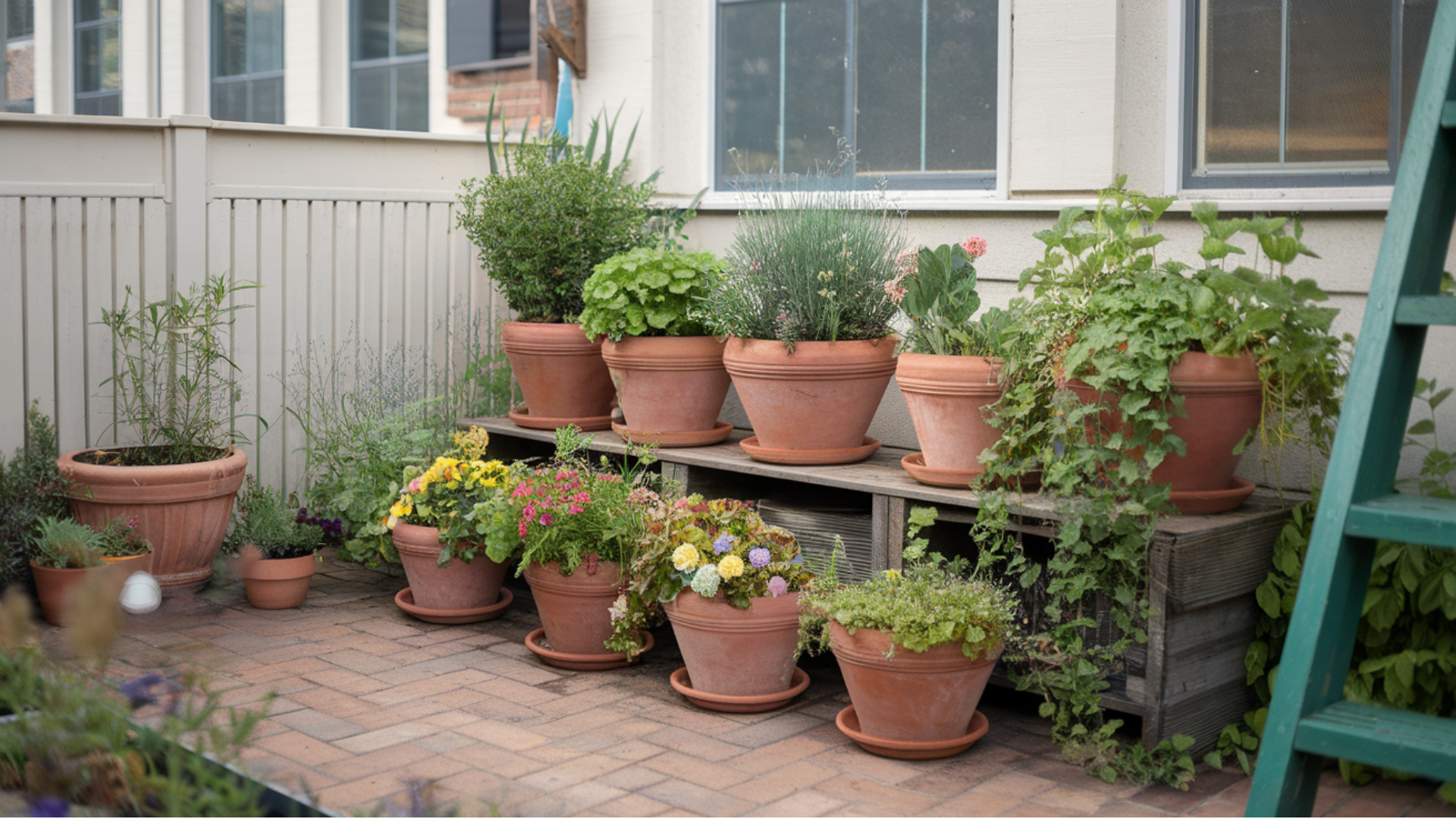
This flower pot idea saves space and looks eye-catching on small patios or porches. By stacking terracotta pots at angles, you create a tiered setup that holds several plants in one spot.
It’s great for mixing herbs, flowers, or trailing vines. The layered look adds both height and color, giving a small area more life without needing much room.
DIY Option:
- Thread a metal rod through the pot holes for stability.
- Start with the largest pot and angle smaller ones upward.
- Fill each layer with soil and plant different varieties.
2. Painted Tin Can Pots
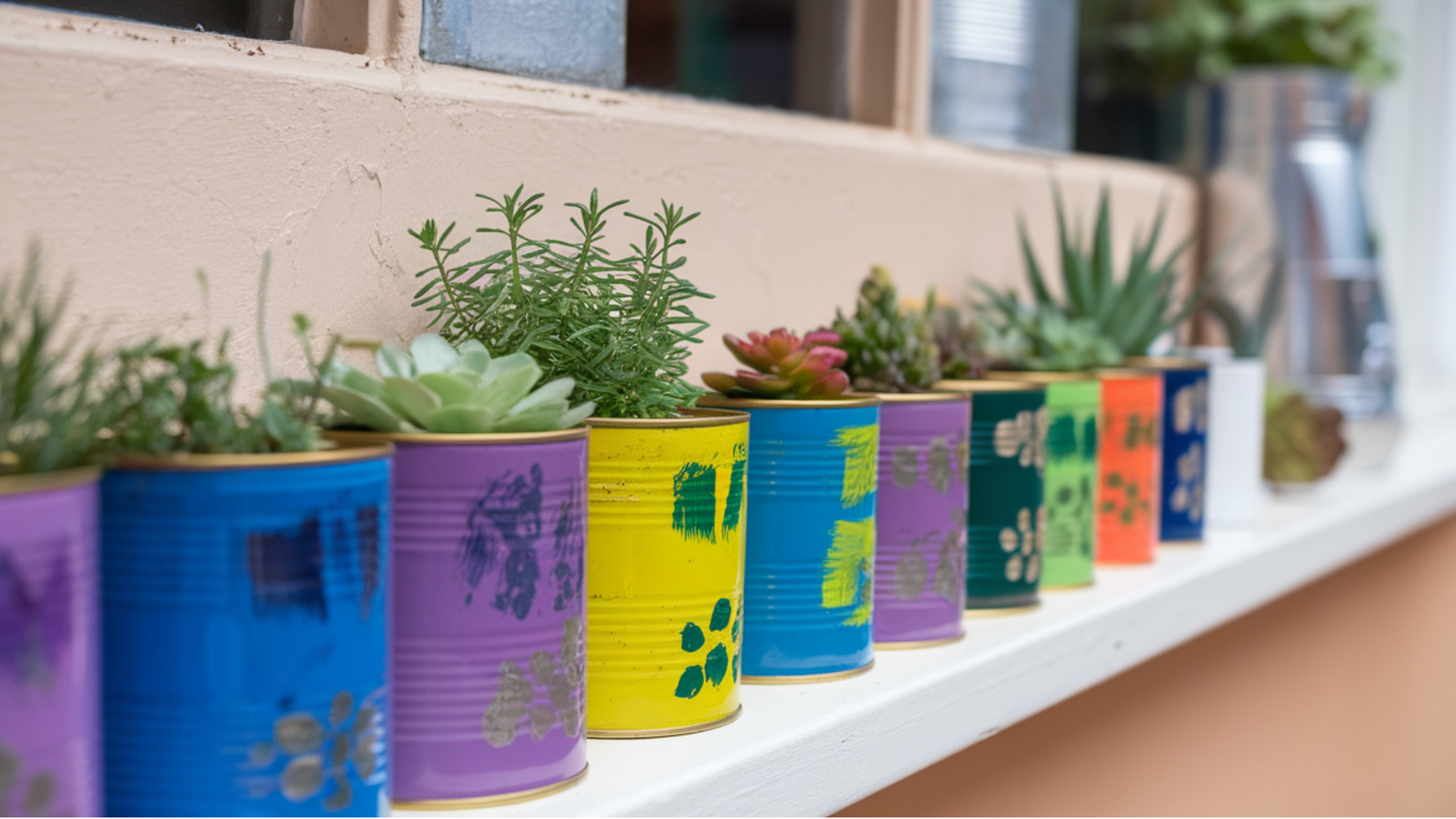
Painted tin cans are an easy way to add style to your outdoor setup on a small budget. They’re great for herbs, flowers, or succulents and fit well on window ledges or railing shelves.
You can choose colors that match your space or go bold with patterns. It’s a fun and simple project, even for beginners or kids helping out with gardening.
DIY Option:
- Clean cans and poke 3–4 drainage holes at the bottom.
- Spray or brush on acrylic paint; let dry fully.
- Fill with soil and plant herbs or small blooms.
3. Vertical Shoe Organizer Planters
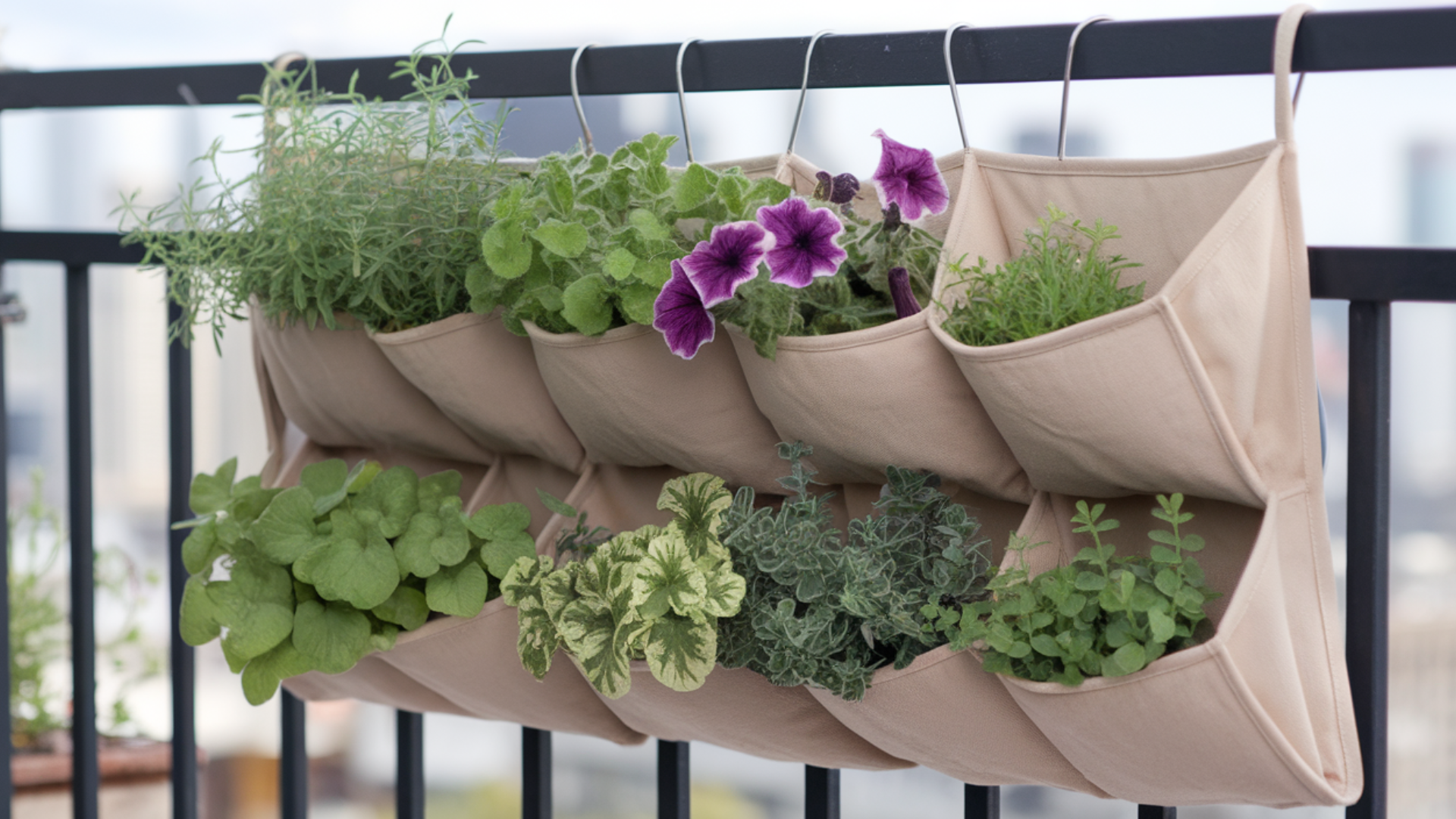
Turn a basic fabric shoe organizer into a vertical planter that’s perfect for balconies or small porches. Each pocket acts like a mini pot, holding soil and small plants like herbs or petunias.
It uses zero floor space and creates a neat green wall. It’s especially handy for renters who can’t build permanent setups but want to grow multiple plants.
DIY Option:
- Hang the organizer on a wall, fence, or railing with hooks.
- Line pockets with plastic if needed, then add potting soil.
- Plant herbs, flowers, or greens in each pocket.
4. Colander Flower Pot

Colanders already have built-in drainage, which makes them perfect for planting. Their size works well for herbs, succulents, or trailing flowers. You can place them on a stand or hang them by the handles.
A colorful or vintage colander adds character to any outdoor space, especially if you’re going for a cozy, casual look.
DIY Option:
- Line the inside with coconut liner or landscape fabric.
- Add potting soil and plant your choice of greenery.
- Hang using a sturdy chain or place on a garden stand.
5. Chair Seat Planter
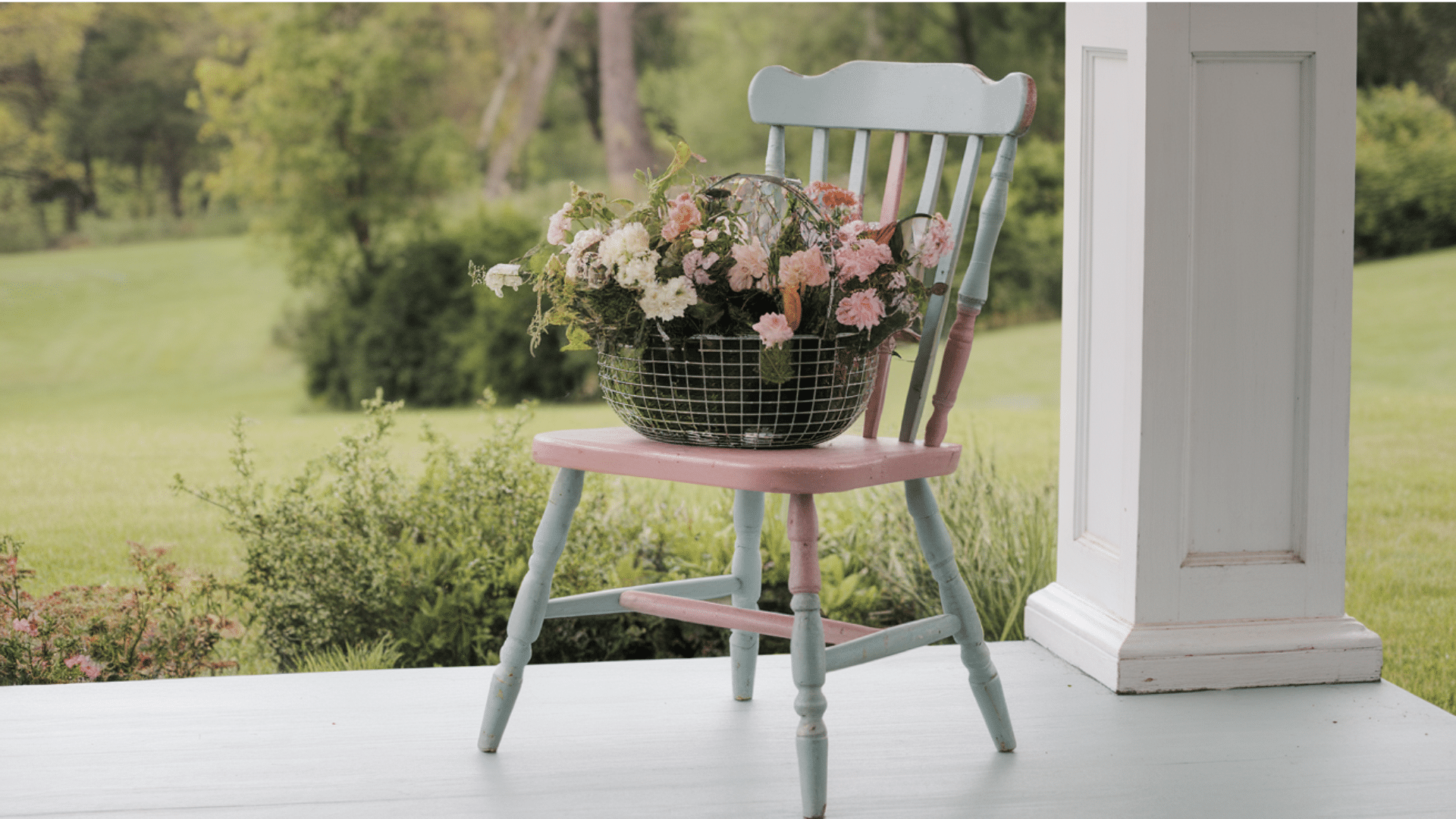
Old chairs can become standout planters with just a few changes. Removing the seat and replacing it with a basket or pot turns a worn-out chair into a garden feature.
It’s a clever way to add height to a plant display and bring personality to your porch. This works well for both rustic and modern spaces, depending on how you finish the chair.
DIY Option:
- Remove the seat and sand or paint the chair frame.
- Insert a pot or wire basket where the seat was.
- Fill with soil, add flowers, and place in a corner spot.
6. Teacup or Teapot Planters

Old teacups or teapots make perfect small planters for herbs, succulents, or petite flowers. Their compact size and fun designs add a personal touch to any patio or balcony.
These containers work best on tables or shelves and are ideal for creating a cozy, lived-in feel. You can mix different patterns or use matching sets for a tidy display.
DIY Option:
- Drill a small drainage hole or add pebbles to the bottom.
- Fill with cactus or potting mix.
- Plant a low-maintenance succulent or herb.
7. Ladder Plant Stand
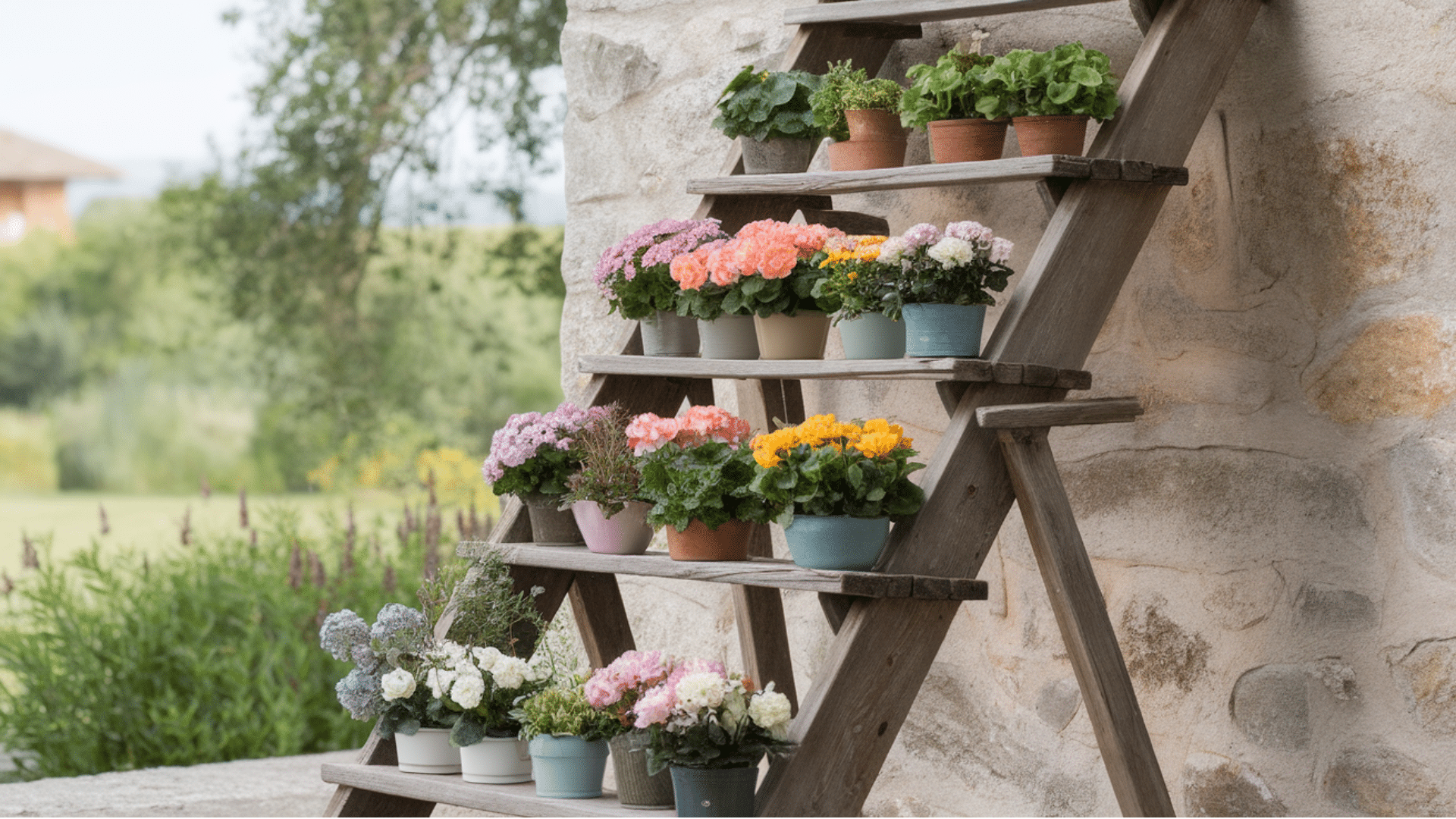
A wooden ladder turned plant stand is a great way to use vertical space. Each step acts like a mini shelf, giving you room for multiple pots. It’s easy to lean against a wall or railing, and it creates a layered look.
You can use it to organize plants by size or sunlight needs. Paint or stain the ladder to match your style.
DIY Option:
- Sand and paint or seal the ladder for outdoor use.
- Place flower pots on each step or rung.
- Add hooks or baskets to the sides for more space.
8. Rain Boot Pots
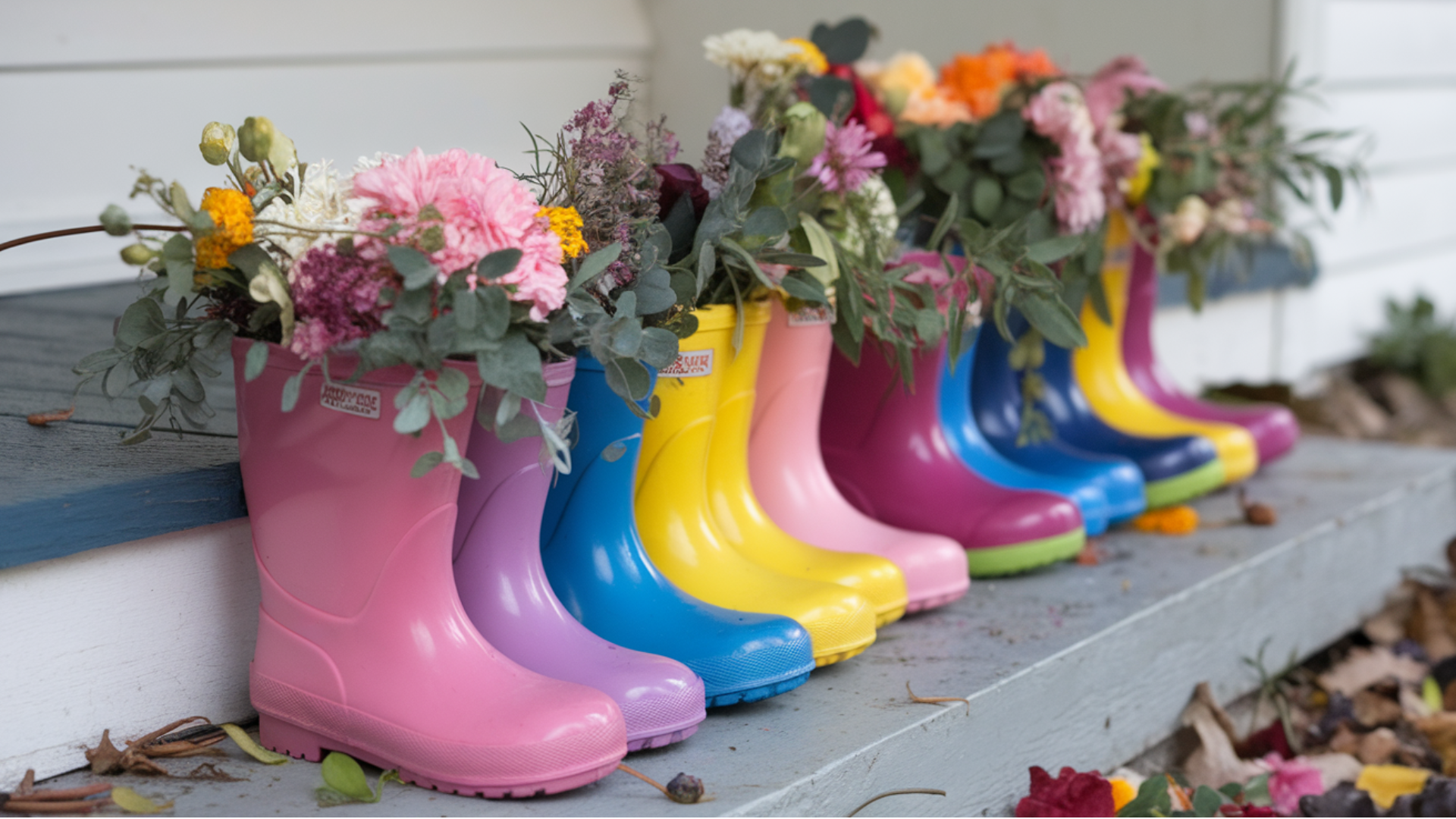
Outgrown or worn-out rubber boots can become colorful planters. They’re already waterproof, and their tall shape works great for flowers with longer stems. These boots add a playful, unexpected touch to small outdoor spaces.
Stand them by the door, line them along a railing, or hang them from hooks for a fun and quirky display.
DIY Option:
- Drill 2–3 holes in the sole for drainage.
- Add gravel or rocks to the bottom.
- Fill with soil and plant cheerful flowers or herbs.
9. Wicker Basket Liners
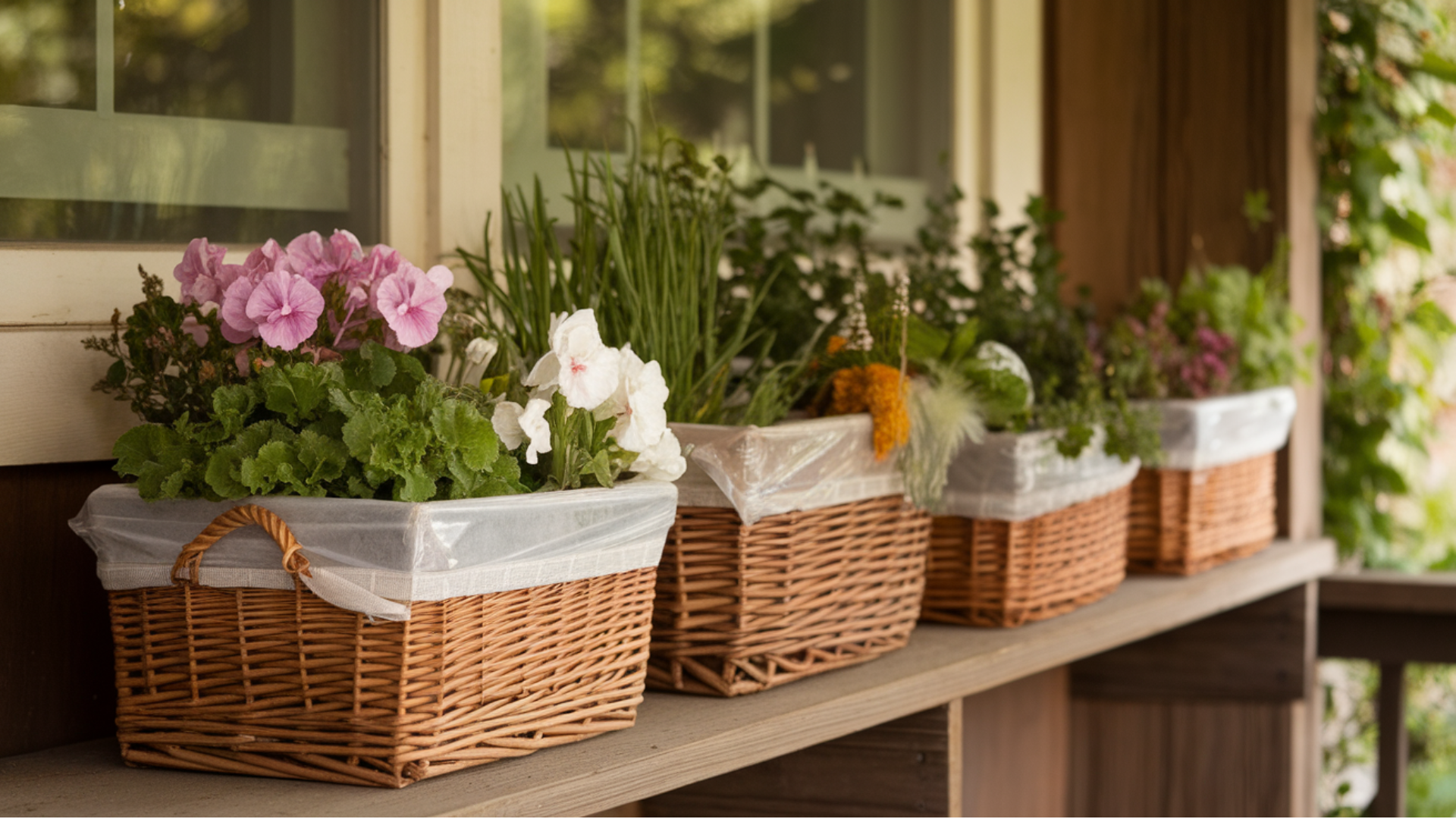
Wicker baskets bring warmth and texture to outdoor setups. They’re lightweight and easy to move, but they need a liner to hold soil.
Use them for flowers, herbs, or even small vegetables. Group different shapes and sizes for a soft, homey feel. They work well in shaded or covered areas to avoid water damage.
DIY Option:
- Line with a plastic bag or landscape fabric.
- Fill with potting soil and your chosen plants.
- Keep under a covered porch to protect from rain.
10. Drawer Planters
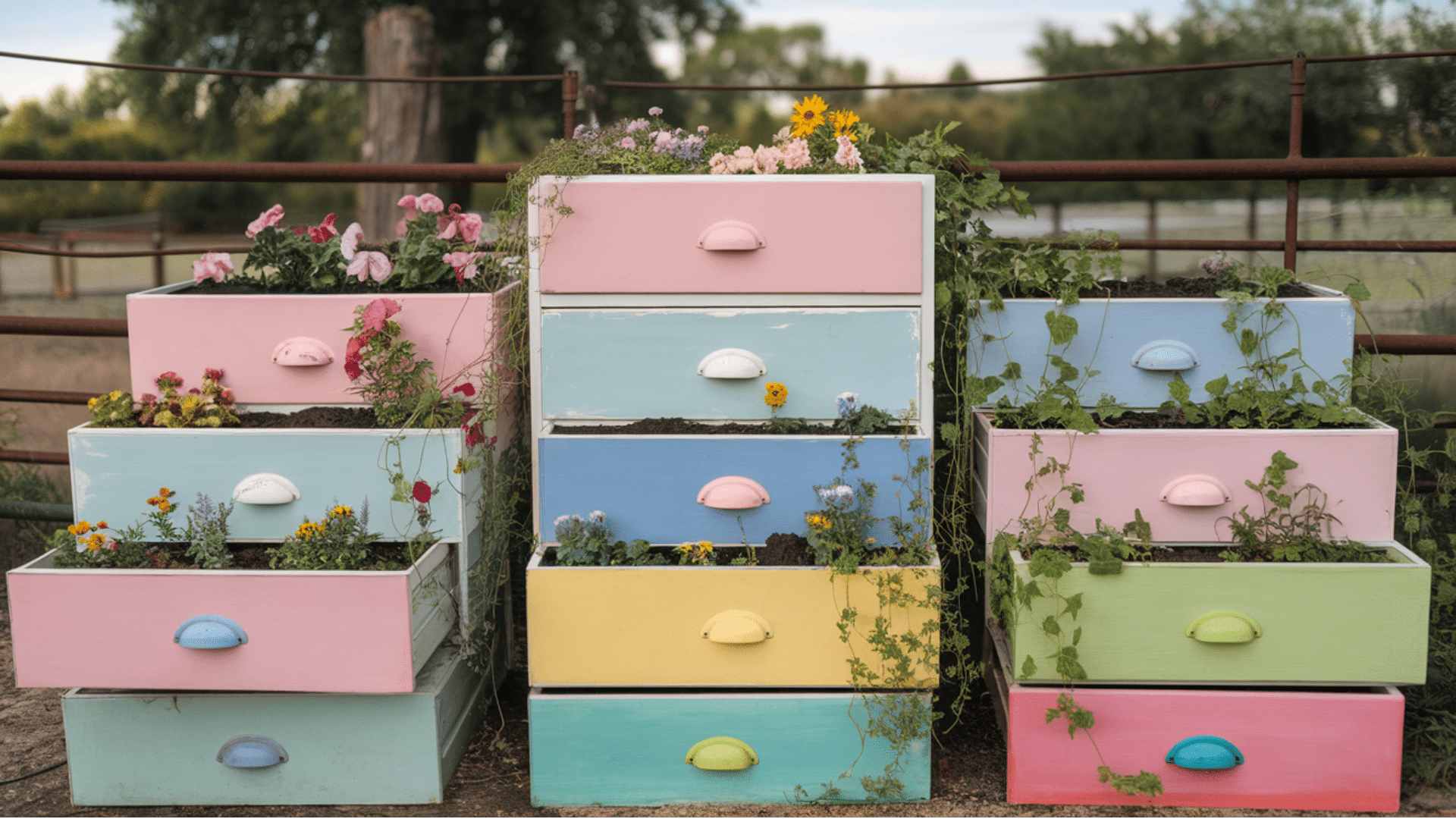
Old drawers from broken dressers make beautiful, rustic flower planters. Their boxy shape gives plenty of room for soil and root growth. You can stack them, add legs, or leave them on the ground for a layered effect.
This idea brings new life to old furniture and adds character to your outdoor space.
DIY Option:
- Drill a few holes in the bottom for drainage.
- Sand and paint or seal the wood for outdoor use.
- Fill with soil and plant flowers, trailing vines, or herbs.
11. Concrete Block Pockets
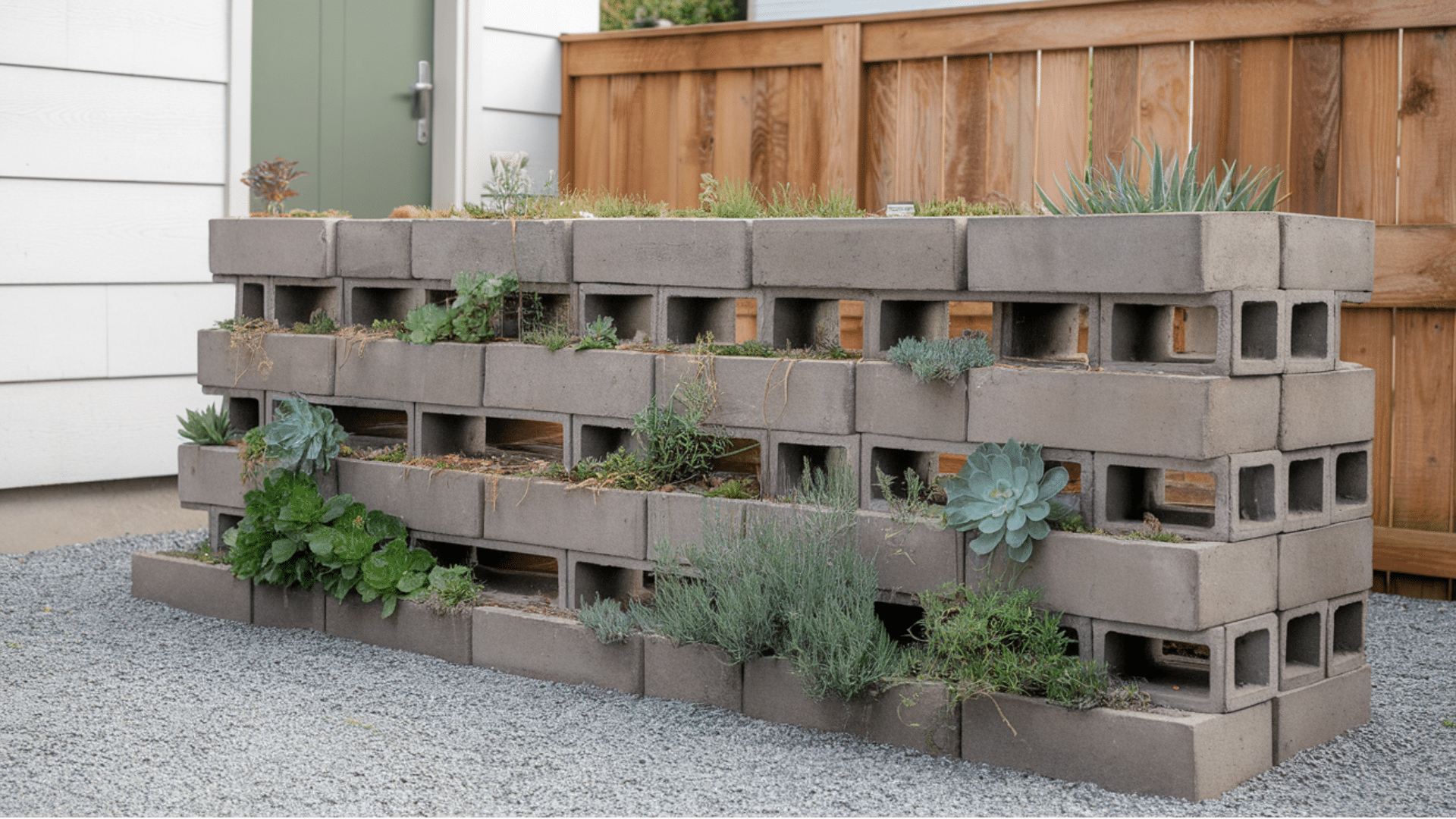
Concrete or cinder blocks can double as planters by using their built-in hollow spaces. They’re sturdy, weather-resistant, and give a modern, industrial edge to your outdoor area.
You can stack them in different shapes to build a low wall or vertical garden. These blocks are great for small succulents, herbs, or flowers that don’t need deep soil. They’re also heavy enough to stay put in windy spaces.
DIY Option:
- Stack blocks securely on a flat surface in your chosen layout.
- Fill each hollow with potting mix.
- Add compact plants or succulents in each pocket.
12. Hanging Mason Jars
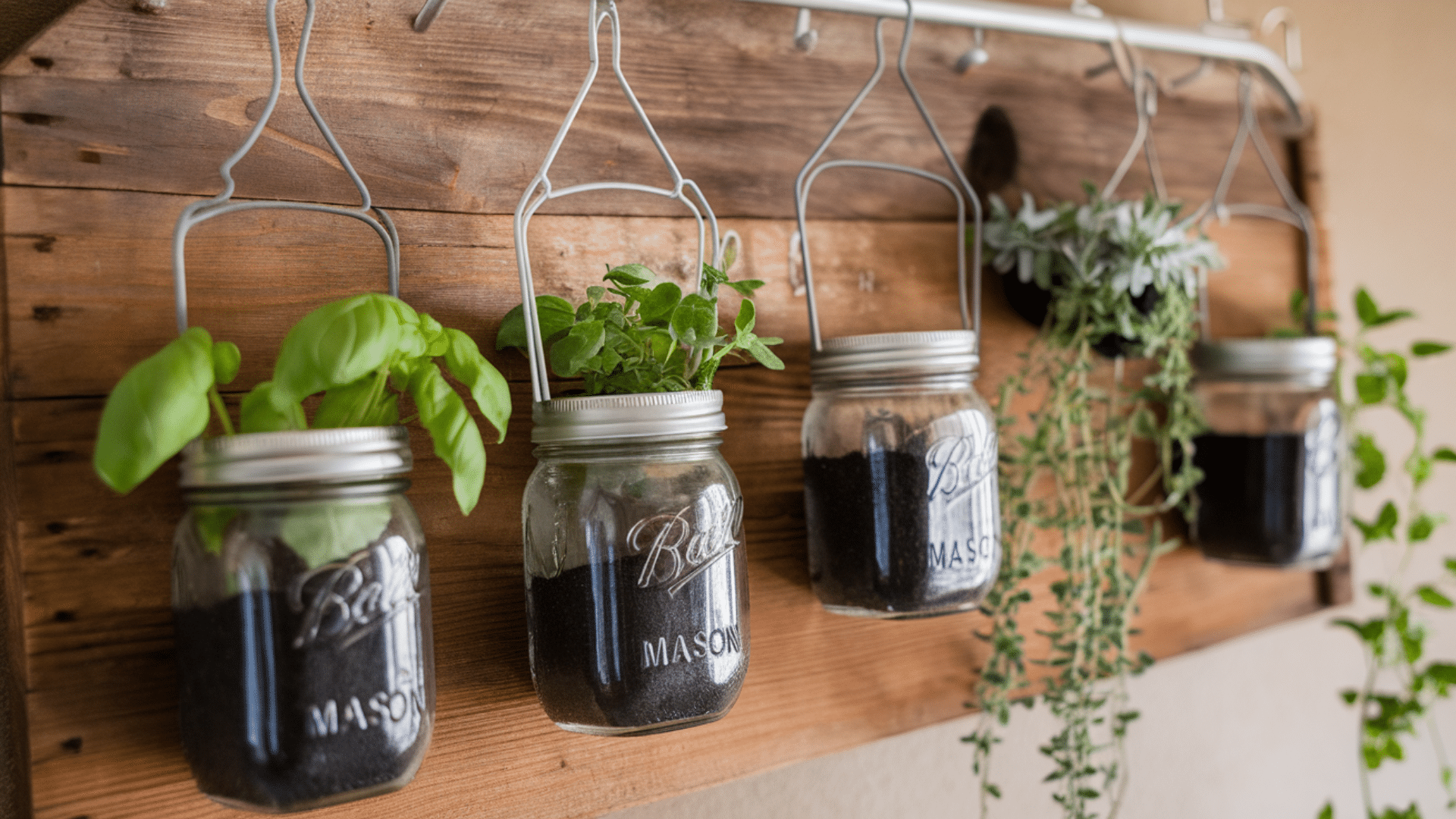
Mason jars aren’t just for kitchens; they also make simple, stylish hanging planters. Their clear glass gives a neat look, and they work well for herbs or trailing plants.
You can hang them from hooks, railings, or boards to make a vertical display. These are ideal for balconies or patios with limited ground space and can double as pretty decor.
DIY Option:
- Wrap wire or twine around the jar’s neck to create a hanger.
- Add small rocks for drainage, then fill with soil.
- Hang from a sturdy hook, beam, or wooden board.
13. Pallet Wall Planter

Wooden pallets can easily become vertical gardens when attached to a wall or leaned upright. The slats form natural shelves where you can place small pots or line them for planting directly.
This setup works well for herbs, flowers, or even leafy greens and saves floor space. It also adds texture and a rustic look to bare outdoor walls.
DIY Option:
- Clean and sand the pallet, then seal it for outdoor use.
- Staple landscape fabric behind each row to hold soil.
- Fill with potting mix and add your plants to each row.
14. Repurposed Paint Cans
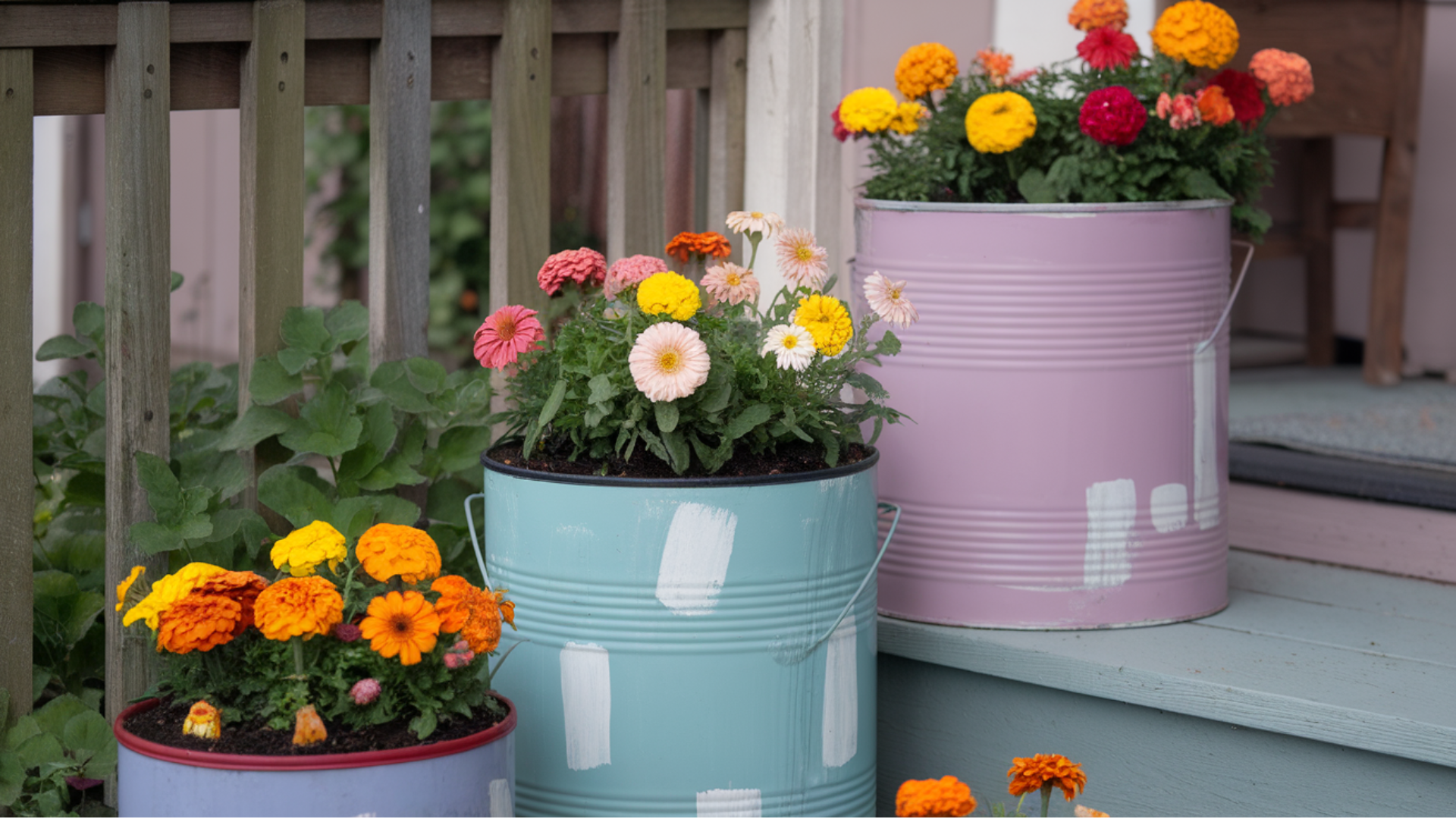
Empty paint cans make sturdy and roomy planters once cleaned out. They hold more soil than typical tin cans and look great when painted or labeled.
Add a handle and hang them, or keep them grouped on the ground. This is a great reuse idea for large or small outdoor areas and adds a bold, industrial feel, depending on how you decorate them.
DIY Option:
- Remove paint residue and rinse cans thoroughly.
- Drill a few drainage holes at the bottom.
- Paint the outside and fill with soil and plants.
15. Wooden Crate Garden
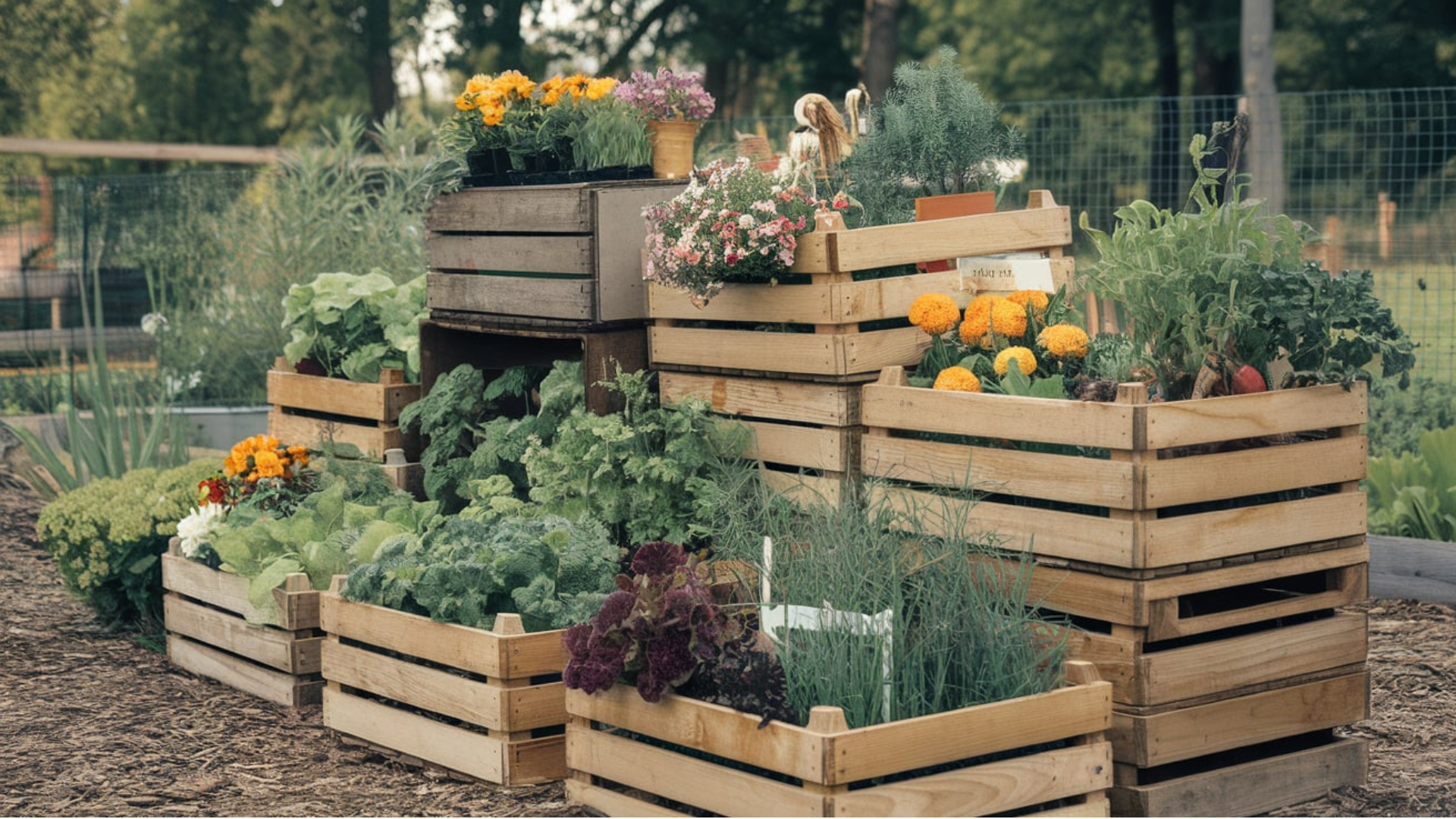
Wooden crates are perfect for planting larger flowers or grouping multiple smaller pots inside. Their open design allows airflow, and they add a nice rustic touch to porches or balconies.
You can leave them natural or paint them to match your decor. Crates can sit on the floor, be stacked, or hung, depending on how much room you have.
DIY Option:
- Line the inside with landscape fabric or a plastic liner.
- Add a layer of gravel at the bottom for drainage.
- Fill with potting soil and arrange your chosen plants.
16. Upcycled Tire Planter

Old tires can be turned into bold and sturdy planters. Whether placed flat or hung on a wall, tires hold a lot of soil and can support larger plants.
You can paint them bright colors for a fun look or stick with black for a modern edge. This option works well for outdoor spaces that need a statement piece and also helps reduce waste.
DIY Option:
- Wash and scrub the tire to remove dirt and debris.
- Paint the outer surface with exterior paint if desired.
- Fill with soil and place upright or hang securely with rope or chain.
17. PVC Pipe Mini Planters
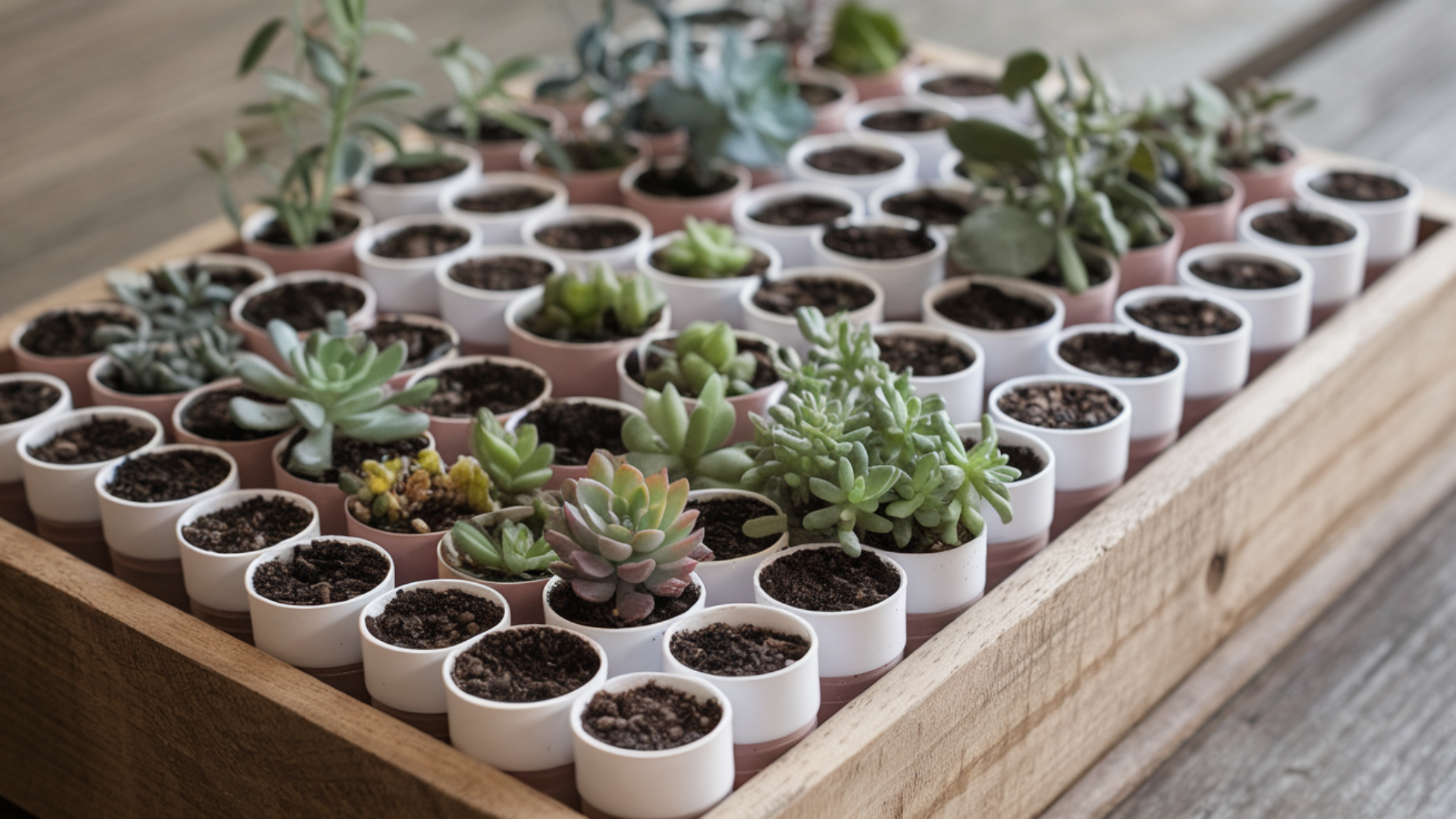
Leftover PVC pipes are great for crafting small, uniform planters that look clean and modern.
Cut into short sections, they work well for herbs, succulents, or seedlings. You can stand them upright, mount them on a board, or attach them to a railing.
Their simple shape makes them easy to group or arrange in patterns, giving your porch or balcony a neat, organized touch.
DIY Option:
- Cut PVC pipe into 4–6-inch pieces with a handsaw.
- Drill a drainage hole at the bottom of each piece.
- Sand edges, then paint or leave plain before planting.
18. Hanging Birdcage Planter
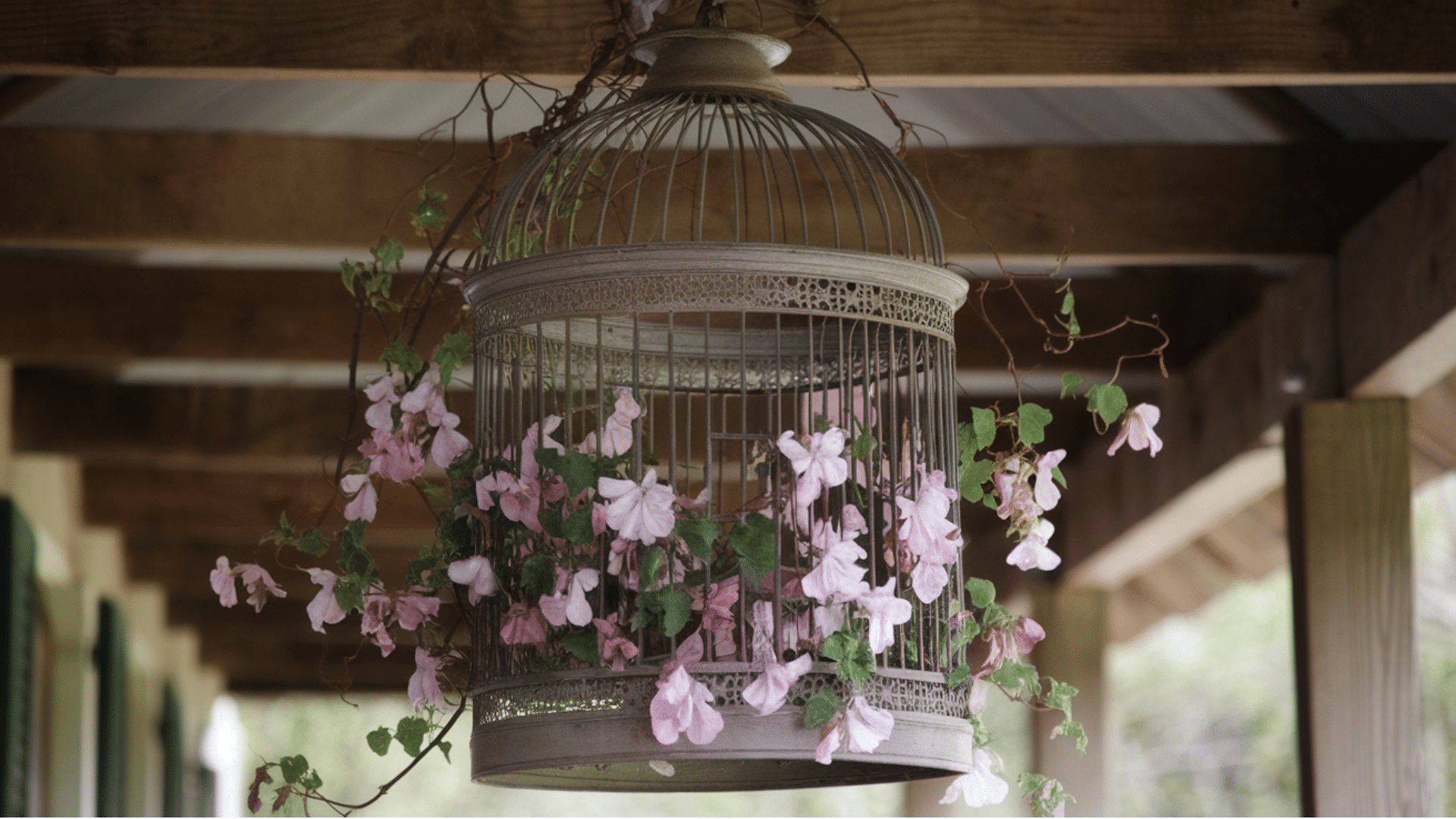
An old birdcage makes a beautiful and unexpected hanging planter. With its rounded shape and open bars, it can hold trailing flowers or vines that spill out for a soft, romantic effect.
It also adds vintage character to your space. Use it as a hanging centerpiece or corner accent for porches or balconies where floor space is limited.
DIY Option:
- Line the base with coconut fiber or a plastic tray.
- Add potting soil and trailing or upright plants.
- Hang with a chain or sturdy rope from a hook or beam.
19. Old Toy Truck Flower Pot
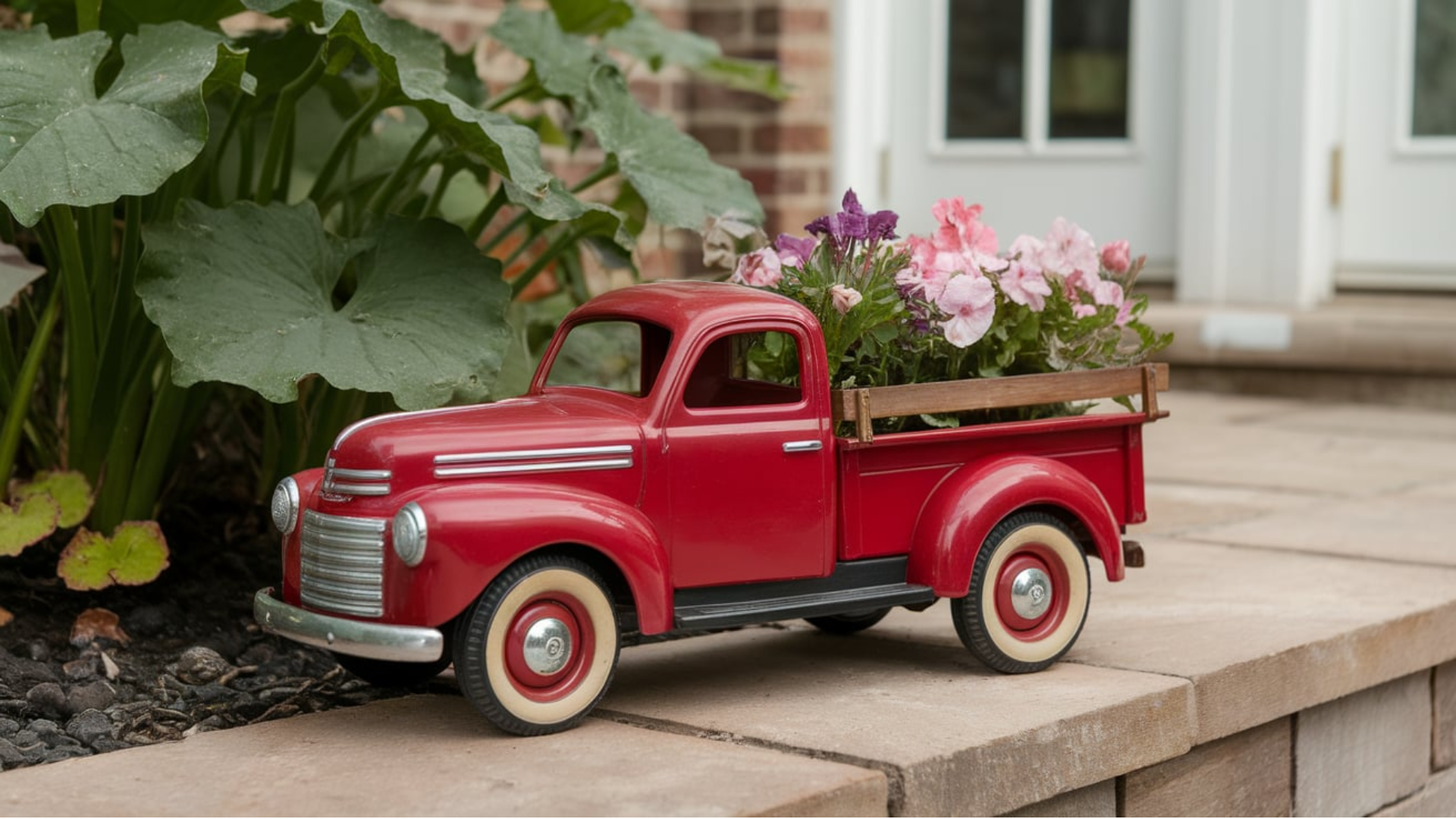
If you have a forgotten toy truck lying around, turn it into a fun and nostalgic planter. The open bed or cab makes a perfect space for flowers or succulents.
It’s especially beautiful on front porches or garden steps and makes for a great conversation starter. This idea adds personality and works well for rustic, playful, or family-friendly outdoor decor.
DIY Option:
- Clean out the toy truck and remove any loose parts.
- Drill small holes for drainage in the base of the truck bed.
- Fill with soil and plant low-maintenance blooms or succulents.
20. Tree Stump Pot Holder
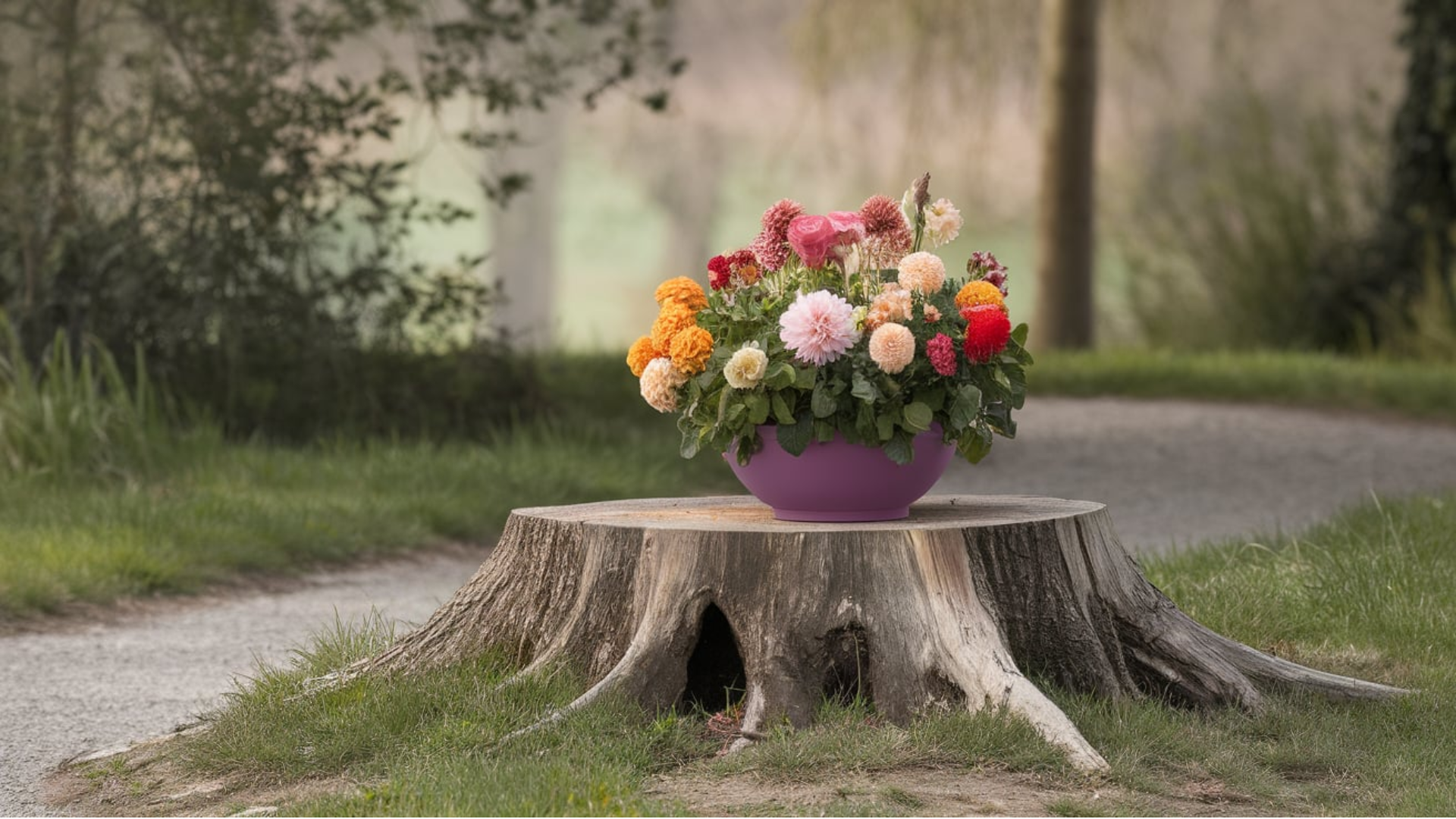
A tree stump can act as a natural pedestal for a flower pot or be hollowed out to plant directly into. It brings an earthy, grounded feel to your outdoor space and mixes beautifully with surrounding plants.
This is a great way to use stumps that are already in your yard or found during yard clean-ups. It adds height and texture without needing extra materials.
DIY Option:
- Level the top of the stump to create a flat surface.
- Hollow out the center with a chisel or use it as a pot stand.
- Place your chosen pot on top, or fill the hollow with soil and plant.
21. Repurposed Mailbox Planter
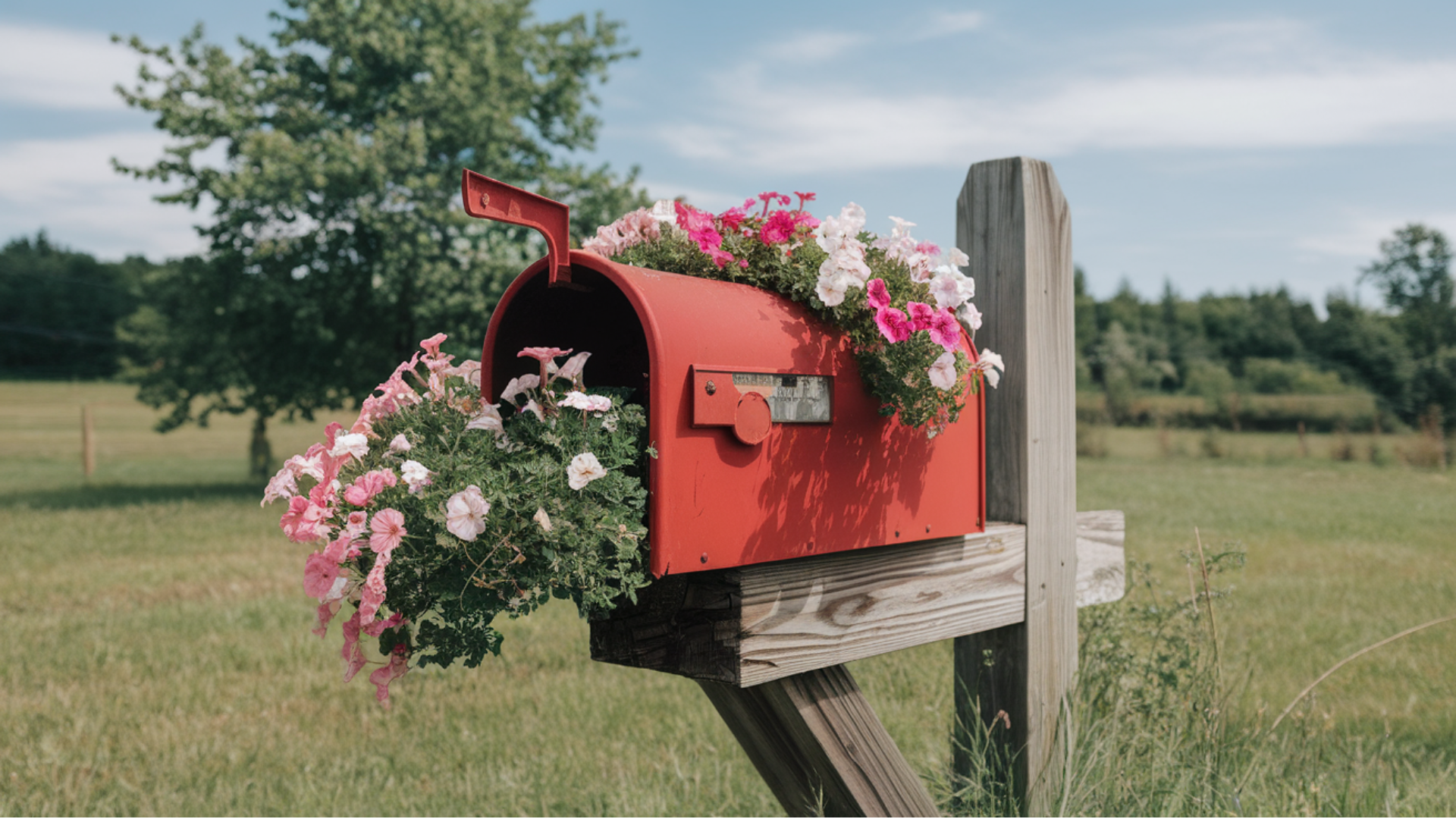
An old mailbox can be a clever planter with built-in beauty. Whether mounted on a post or placed flat, it holds flowers, herbs, or trailing vines beautifully.
Its narrow shape fits tight spaces, and the curved top adds visual interest. Painted or left weathered, it suits rustic and cottage-style patios. Use it to brighten up a porch corner or line a walkway with a row of them.
DIY Option:
- Clean out the mailbox and remove rust if needed.
- Drill drainage holes at the bottom.
- Fill with soil and plant trailing or upright flowers.
22. Recycled Wine Box Planter

Wooden wine boxes are ideal for shallow-rooted plants and herbs. They have a built-in rustic look and can sit on shelves, railings, or tabletops. Stack them or line them up for a uniform planter display.
They’re lightweight, easy to move, and give off a warm, homey vibe. Great for renters or small patios where full garden beds aren’t possible.
DIY Option:
- Line the box with landscape fabric or plastic.
- Add a layer of gravel for drainage.
- Fill with potting soil and plant small herbs or flowers.
23. Hanging Colander Basket
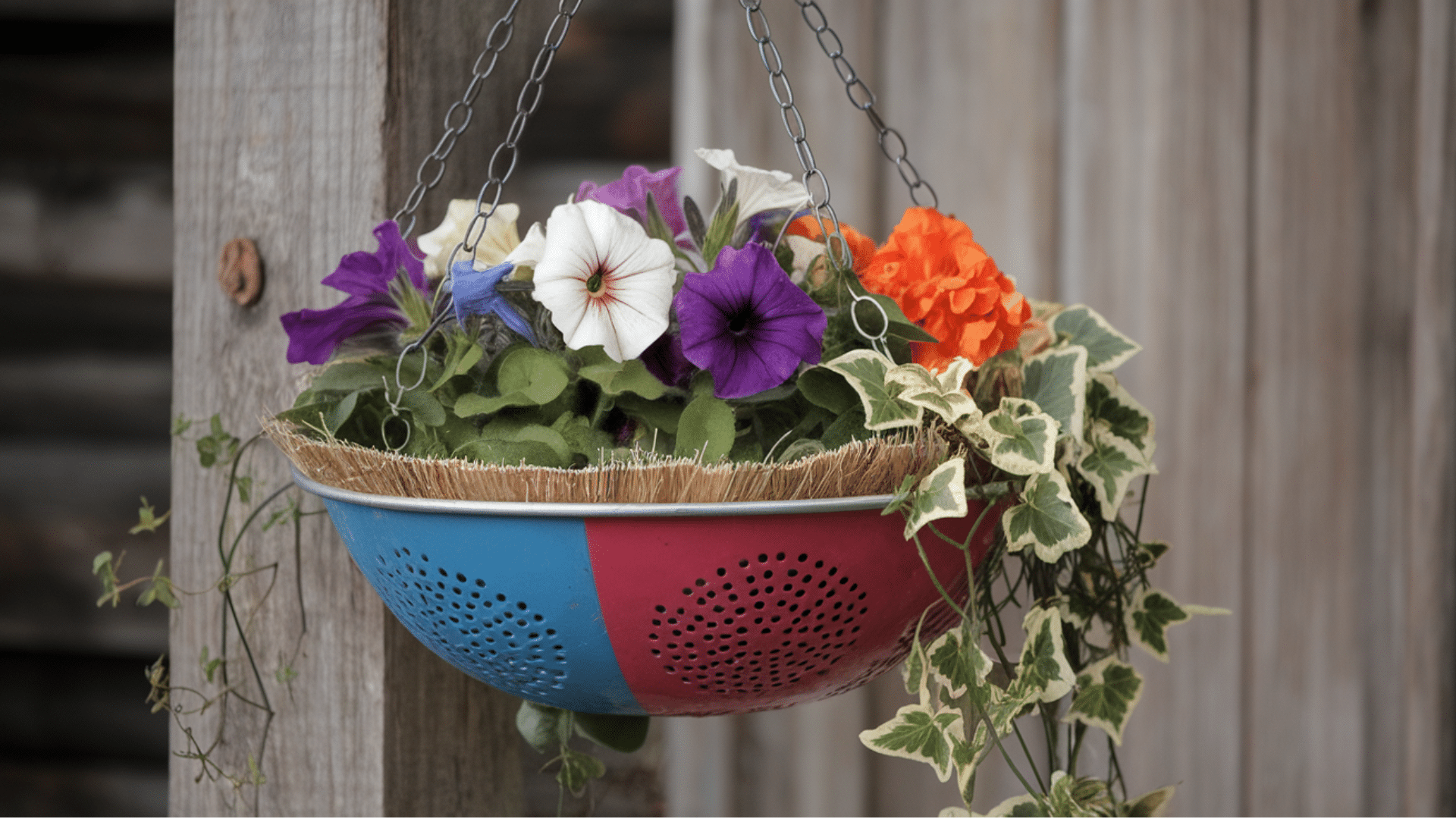
A hanging colander works just like a wire basket but with more style and built-in drainage. Perfect for trailing flowers or vines, it looks great on hooks, porches, or over railings.
Choose bold-colored metal or enamel colanders to make them pop. This planter suits small areas where you want to add hanging greenery without spending much.
DIY Option:
- Line the colander with coconut fiber or mesh fabric.
- Add soil and your chosen plants.
- Use a chain or rope to hang from a sturdy hook or beam.
24. Tiled Mosaic Pot
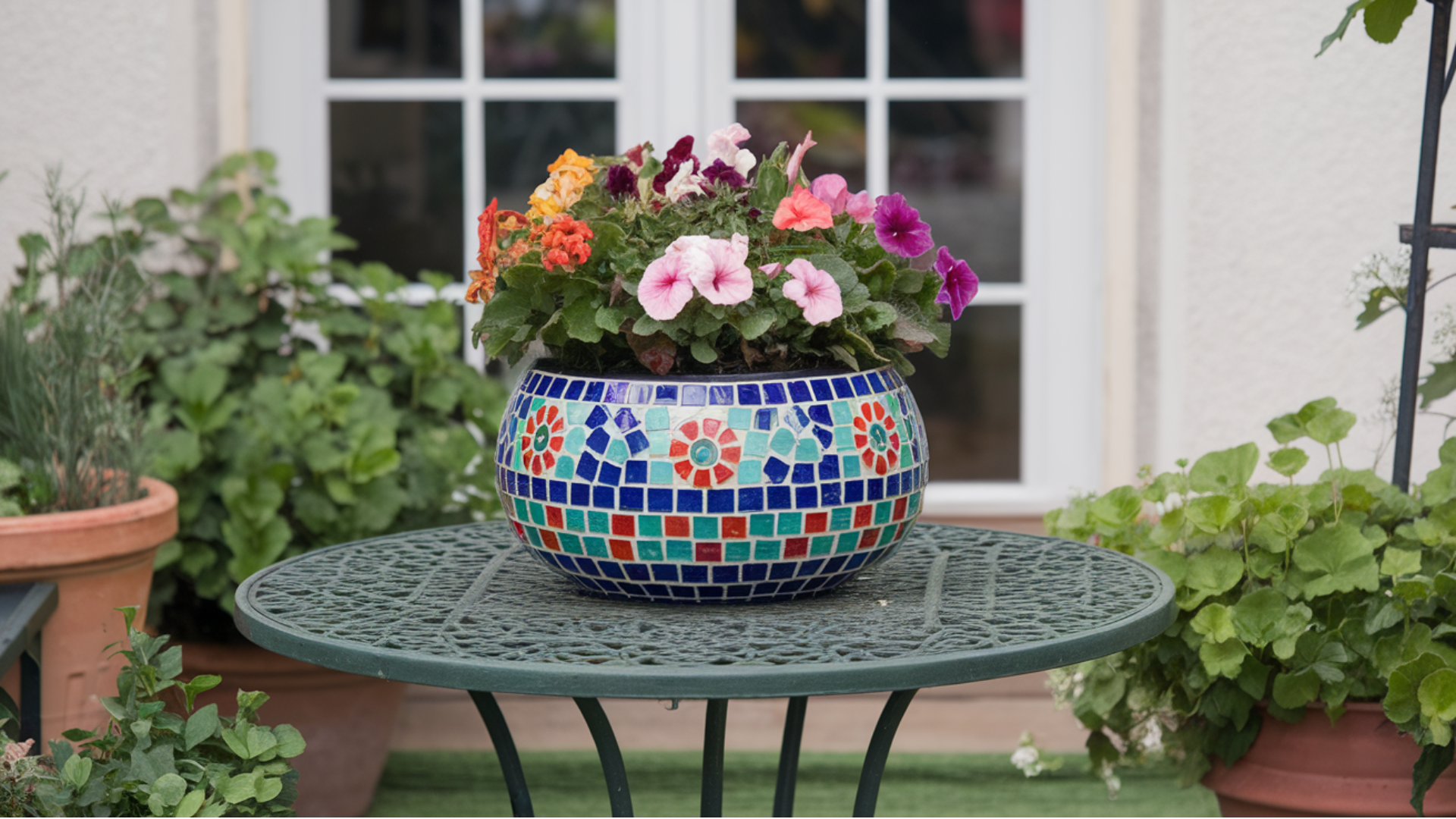
Create a statement piece by adding mosaic tiles to a basic flower pot. The colorful tile patterns instantly upgrade plain containers and let you personalize your setup.
Whether using leftover tile bits or decorative stones, this project gives you a bright and artsy look that stands out. It’s a great choice for patios needing color or detail.
DIY Option:
- Spread tile adhesive over a clean pot surface.
- Press on small tiles or glass pieces in your pattern.
- Once dry, apply grout and wipe clean.
25. Fabric Grow Bags
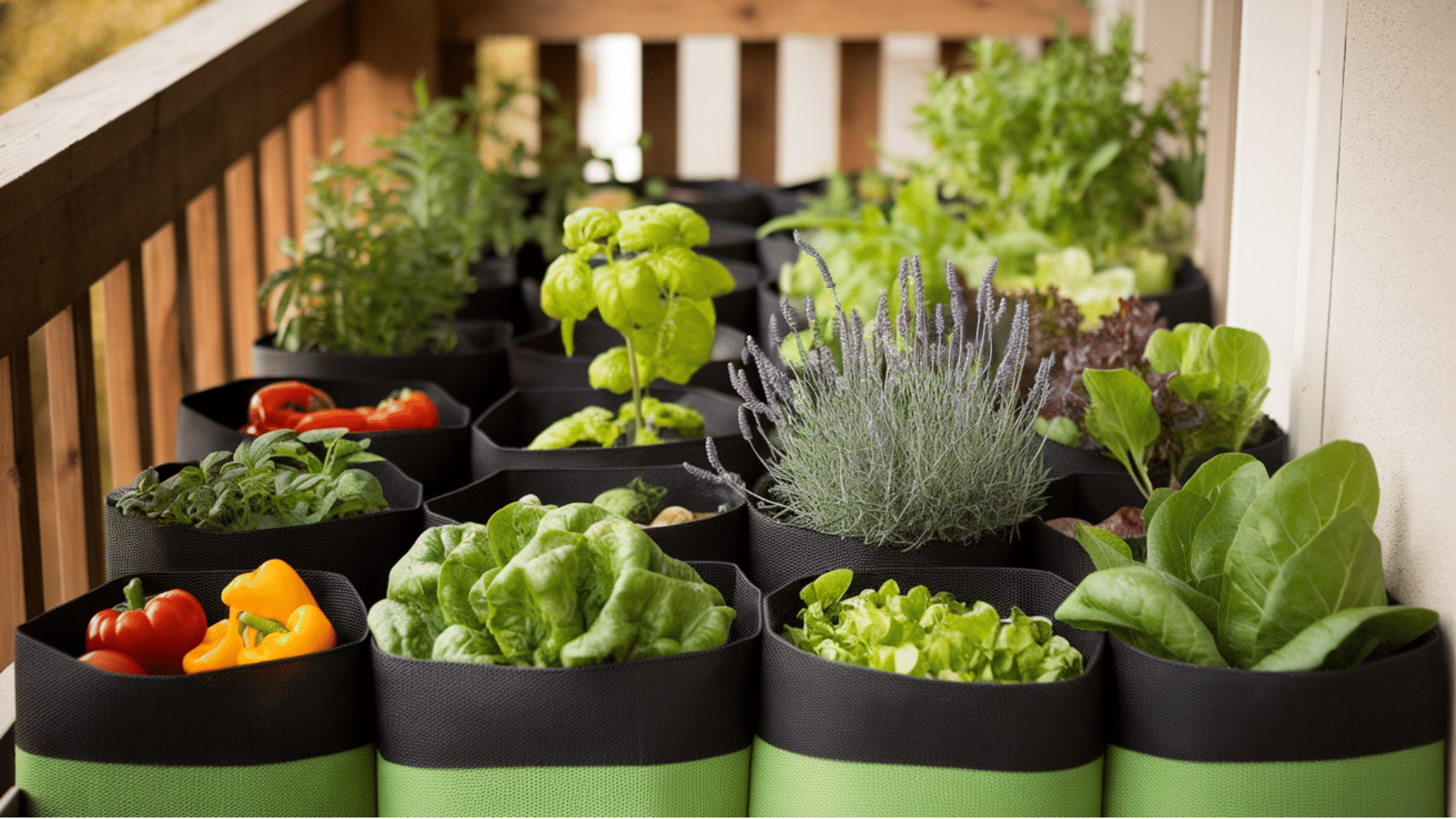
Fabric grow bags are breathable, flexible containers perfect for small balconies or patios. They help roots stay healthy and prevent overwatering.
These bags come in all sizes and are easy to move around or fold up when not in use. They’re great for growing veggies, herbs, or flowers in tight spaces and offer a more casual look than ceramic pots.
DIY Option:
- Buy or sew bags from heavy-duty landscape fabric.
- Fill with potting mix suited for your plant type.
- Water regularly and lift slightly to ensure drainage.
26. Metal Bucket Planters
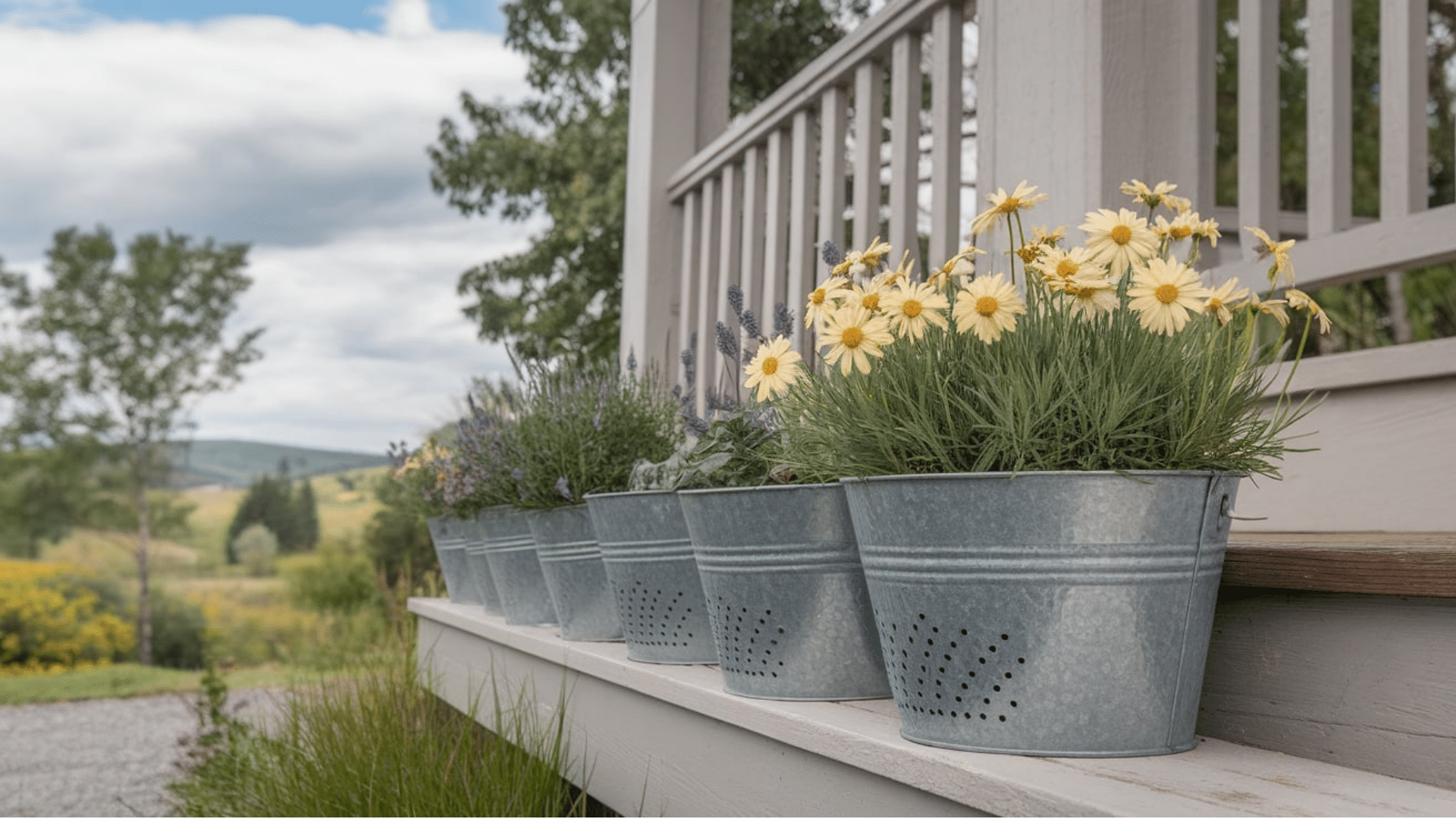
Galvanized metal buckets offer a farmhouse look and are large enough to hold bigger plants or clusters of smaller ones. Their silver sheen pairs well with greens and florals. You can paint them or leave them raw for a rustic touch.
Perfect for porches with wood or brick backdrops, they’re also easy to carry and rearrange.
DIY Option:
- Drill holes in the bottom for drainage.
- Add gravel, then potting soil.
- Plant sun-tolerant blooms or grasses.
27. Hanging Coconut Shell Pots
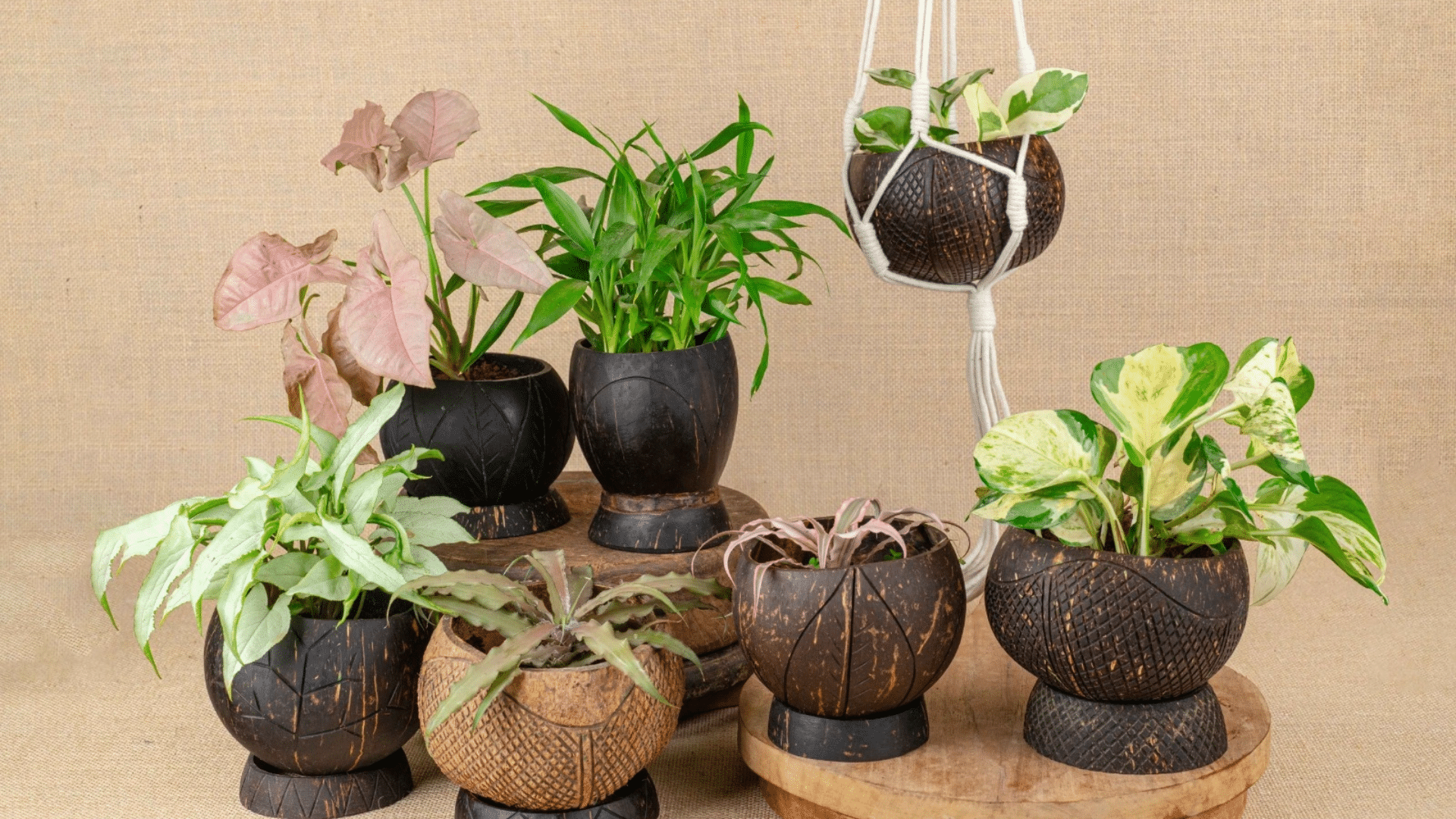
Coconut shells can be turned into tiny hanging pots, giving a natural and earthy vibe. They’re great for air plants or small trailing vines.
These work well in clusters or rows and suit tropical, boho, or minimalist spaces. Lightweight and biodegradable, they’re also an eco-friendly option for small-space gardeners.
DIY Option:
- Cut a coconut shell in half and clean out the inside.
- Drill small holes for hanging and drainage.
- Tie with twine or rope and hang from a hook or rail.
28. Bamboo Cup Planters
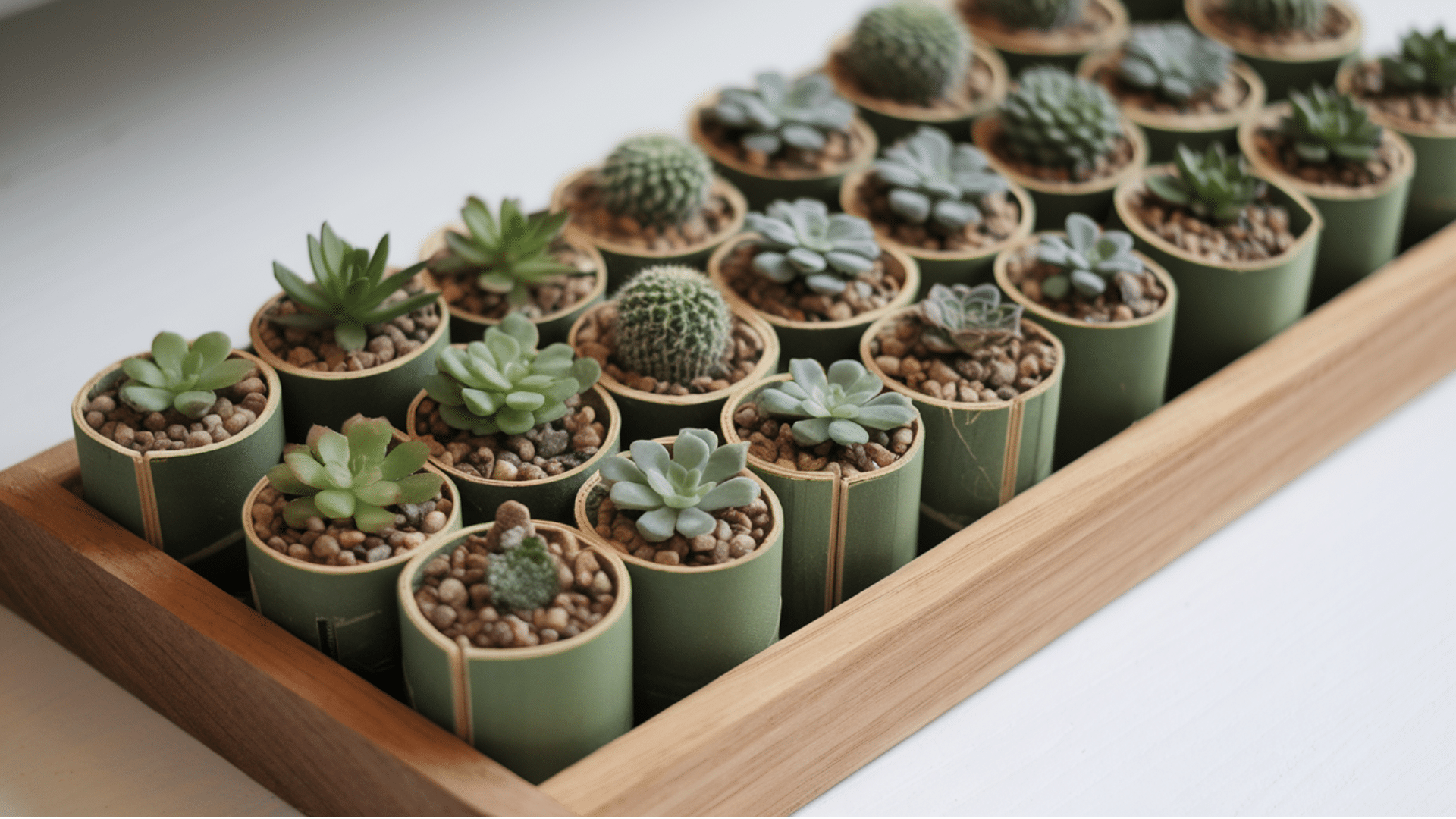
Short bamboo sections make unique mini pots for succulents or cacti. The light color and natural texture add warmth to any setup. These are great for narrow ledges or grouped in trays.
They dry out quickly, making them best for plants that don’t need much water. Perfect for small, organized balcony displays.
DIY Option:
- Cut bamboo stalks into 4–6-inch cups and sand edges.
- Drill a small hole at the base for drainage.
- Add cactus soil and a tiny succulent.
29. Wall-Mounted Gutter Garden
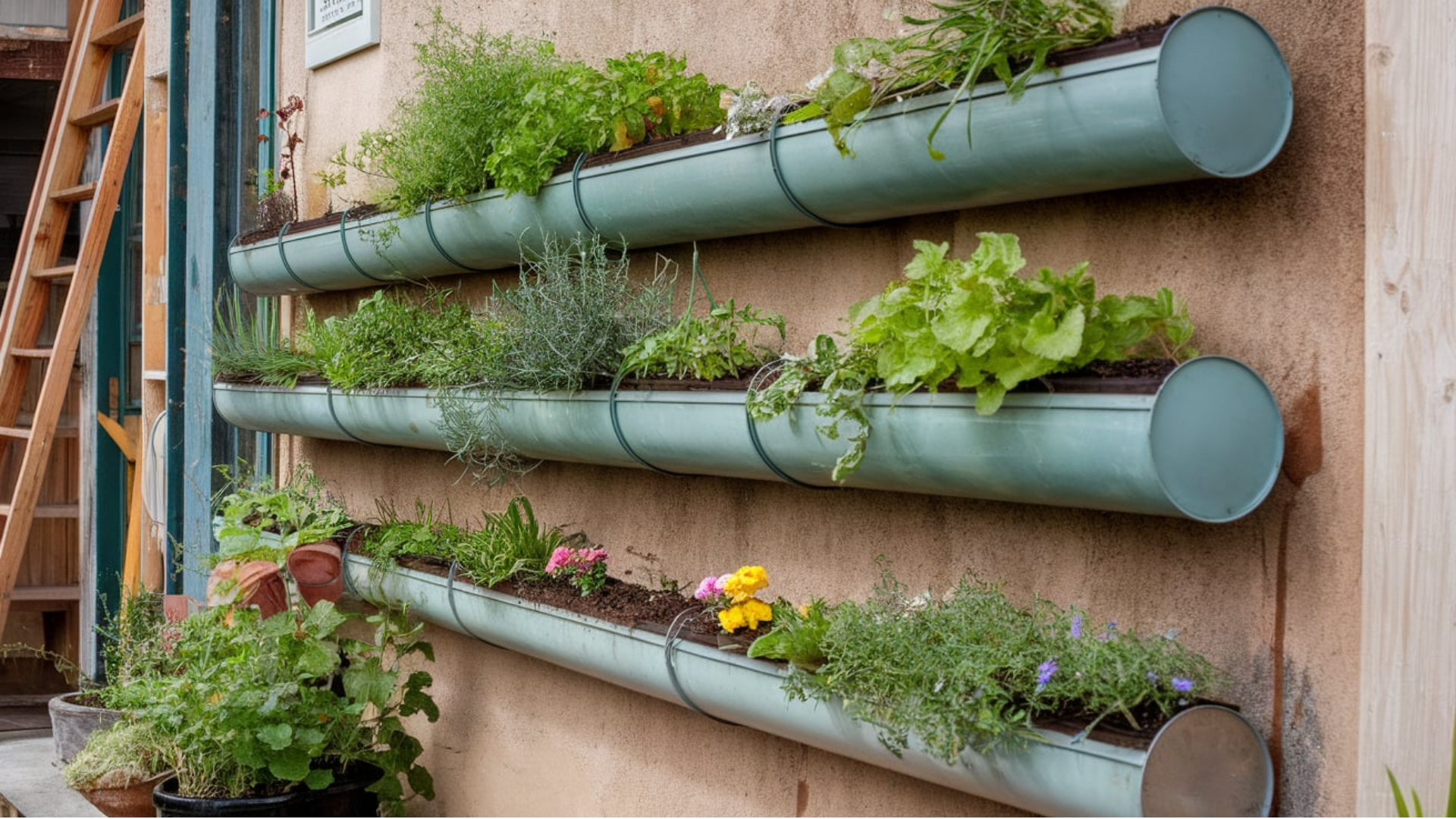
Old rain gutters can be turned into wall-mounted planter strips. Ideal for leafy greens, herbs, or flowers, they use minimal space and offer a clean, uniform look.
Mounting them vertically or in rows turns a plain wall into a productive garden spot. They’re perfect for renters and urban balconies with limited space.
DIY Option:
- Cut gutters to your preferred length and cap ends.
- Mount to a fence or wall using brackets.
- Fill with soil and plant shallow-root veggies or herbs.
30. Old Kettle Flower Pot
A rusty or unused kettle makes a quirky, vintage-style planter. It adds personality to porches or patios and works well for small flowers or herbs.
The spout and handle give it beauty, and it fits beautifully into rustic or cottage-themed outdoor areas. Group several mismatched kettles for an eye-catching arrangement.
DIY Option:
- Clean out the kettle and remove loose rust.
- Drill holes in the bottom for drainage.
- Fill with soil and plant small blooms or herbs.
31. Upcycled Toolbox Planter
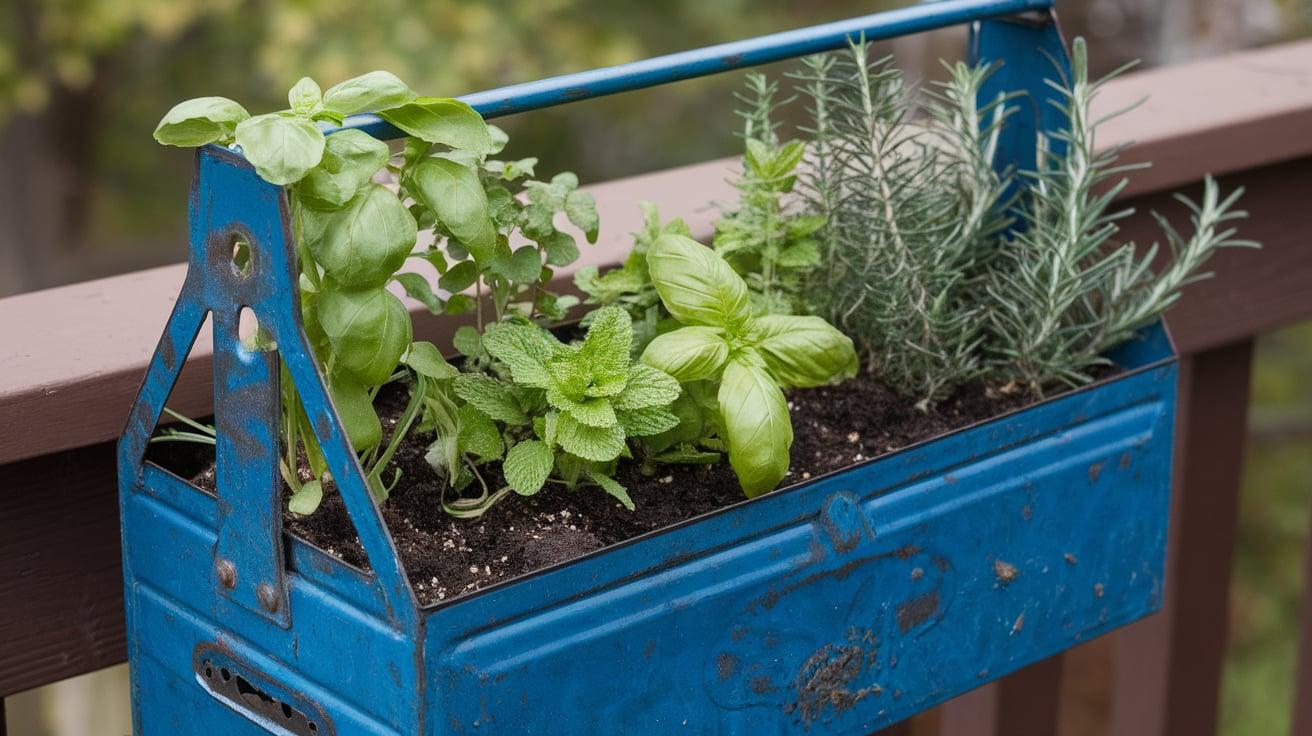
Metal or wooden toolboxes can be repurposed into sturdy, long planters. With built-in handles, they’re easy to move, and their long shape makes them perfect for herbs or lining a railing.
This idea blends rugged style with function and works well in both modern and vintage settings.
DIY Option:
- Clean the toolbox and drill drainage holes in the bottom.
- Paint or leave as-is, depending on your look.
- Fill with soil and plant herbs or trailing flowers.
32. Hanging Wooden Shelf Planter
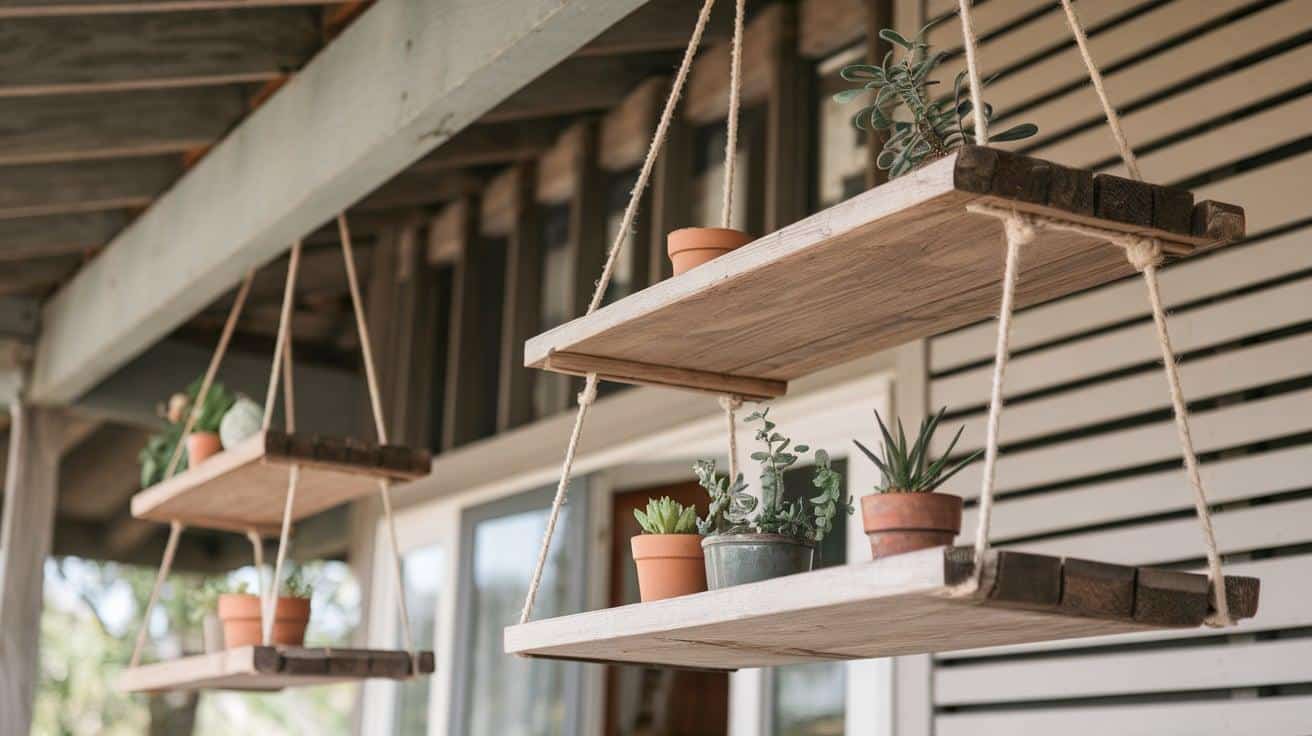
A hanging wooden shelf with potted plants adds style and greenery to any wall or railing. With one or more levels, it creates vertical interest and keeps your pots off the floor.
This is a clean, minimal option that works for renters or tight spaces.
DIY Option:
- Cut wooden planks and drill holes for rope.
- Thread rope through the corners and knot below each shelf.
- Hang from a sturdy hook and place small pots on top.
33. Repurposed Bicycle Basket Planter
A bicycle basket, once detached, becomes a beautiful flower pot holder. It’s a great way to recycle old gear and add whimsy to your patio or porch.
The wire structure holds pots or liners well and works great on walls, railings, or fences. Add flowers that spill over for a full look.
DIY Option:
- Line the basket with coconut liner or landscape fabric.
- Add soil and flowers of your choice.
- Attach to a railing, fence, or wall using hooks or zip ties.
Budget-Friendly Tips for Stylish Planters
You don’t need to spend a lot to have great-looking flower pots. With a few smart choices, you can put together a setup that looks nice and keeps costs low.
These are some easy ways to save money while still making your porch, patio, or balcony look put together:
- Check thrift stores or garage sales for old pots you can clean or repaint.
- Reuse containers like buckets, coffee cans, or old storage bins, just add drainage holes.
- Give old pots a DIY update with spray paint or stencils to match your style.
- Buy soil and plants in bulk with friends or neighbors and split the cost.
- Shop end-of-season plant sales for deals on flowers and planters.
- Look for community garden swaps to trade plants and extras for free.
Conclusion
You don’t need a big yard or a big budget to make your porch, patio, or balcony feel more alive.
A few flower pots can really change how your space looks and feels. I’ve found that even adding one or two made a big difference for me.
You don’t have to do everything at once. Pick one idea from the list and try it out. See how it works for your space.
If you like it, add more when you’re ready. Use what you have, keep it simple, and have fun with it. Flower pots are easy to move, easy to switch, and don’t take much work to enjoy.
I hope these ideas help you get started and feel good about your outdoor space, no matter how small it is. Let me know which ones you try!


